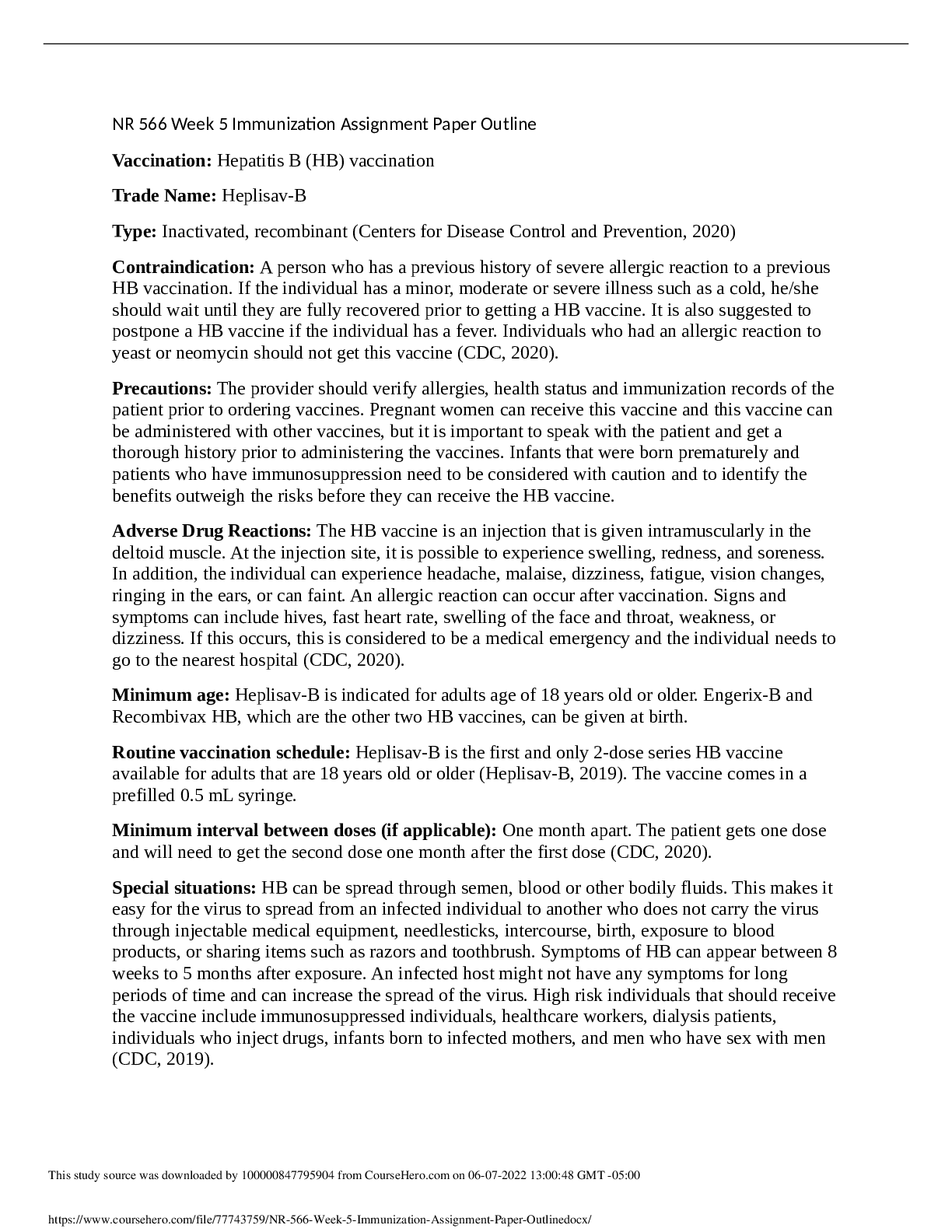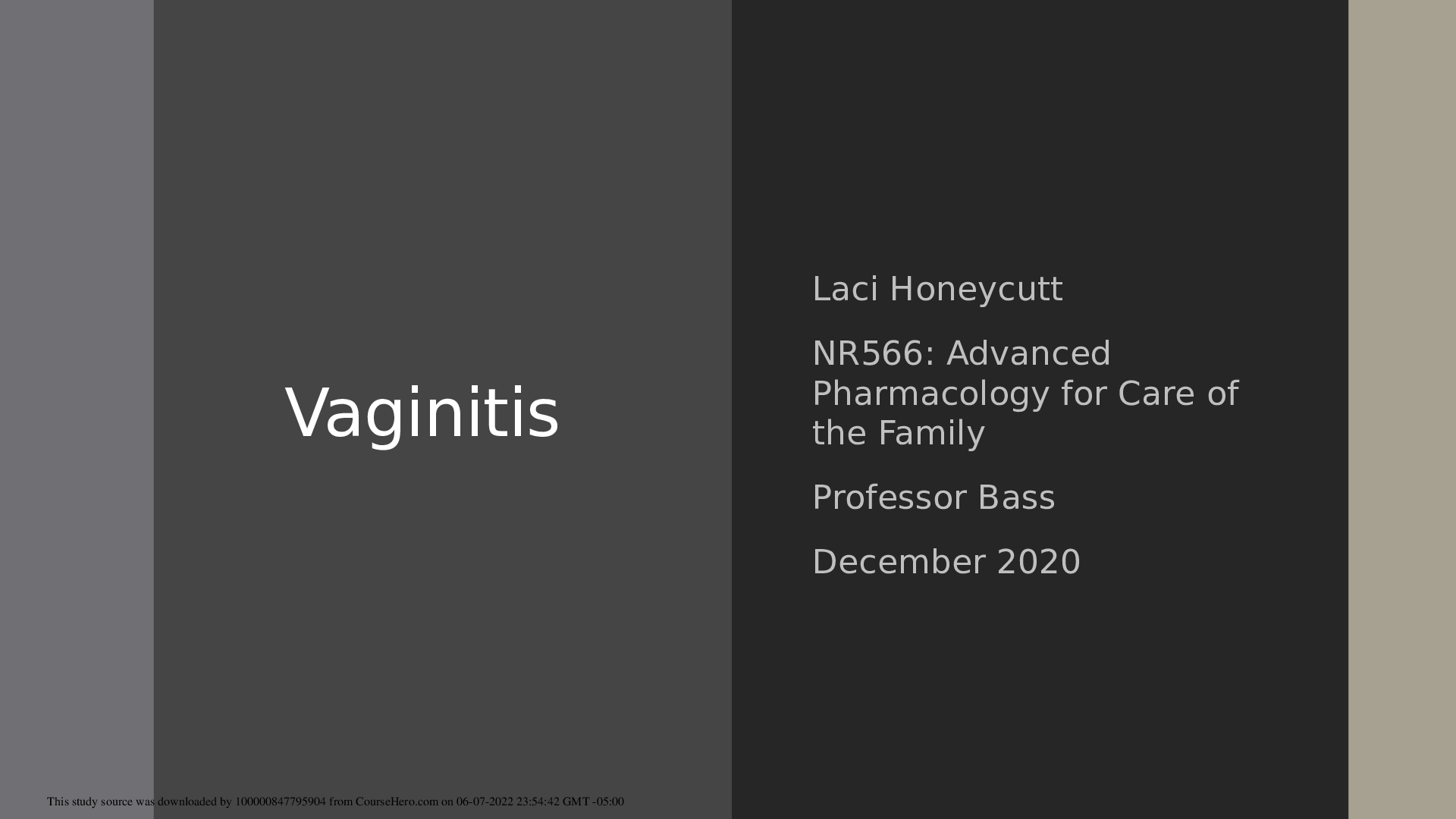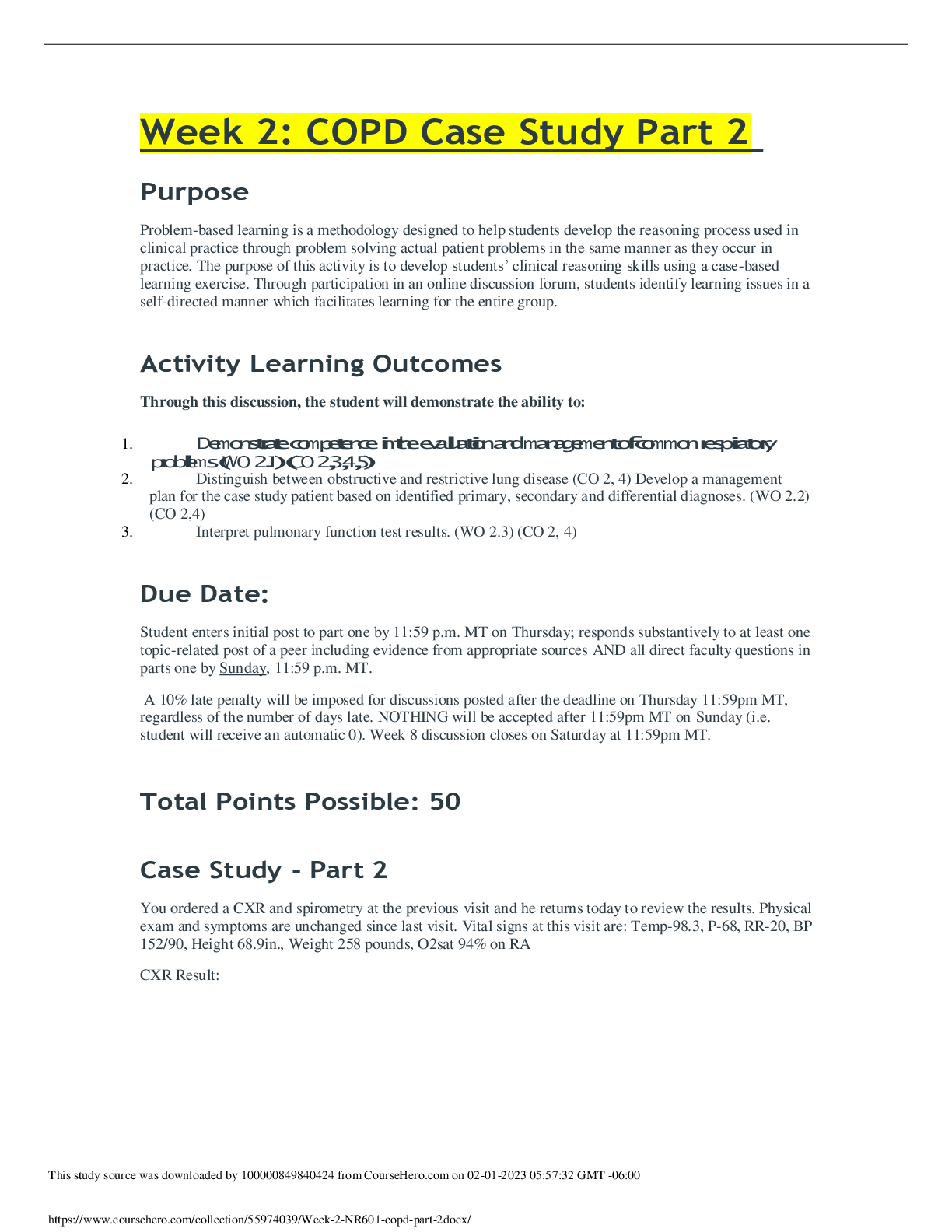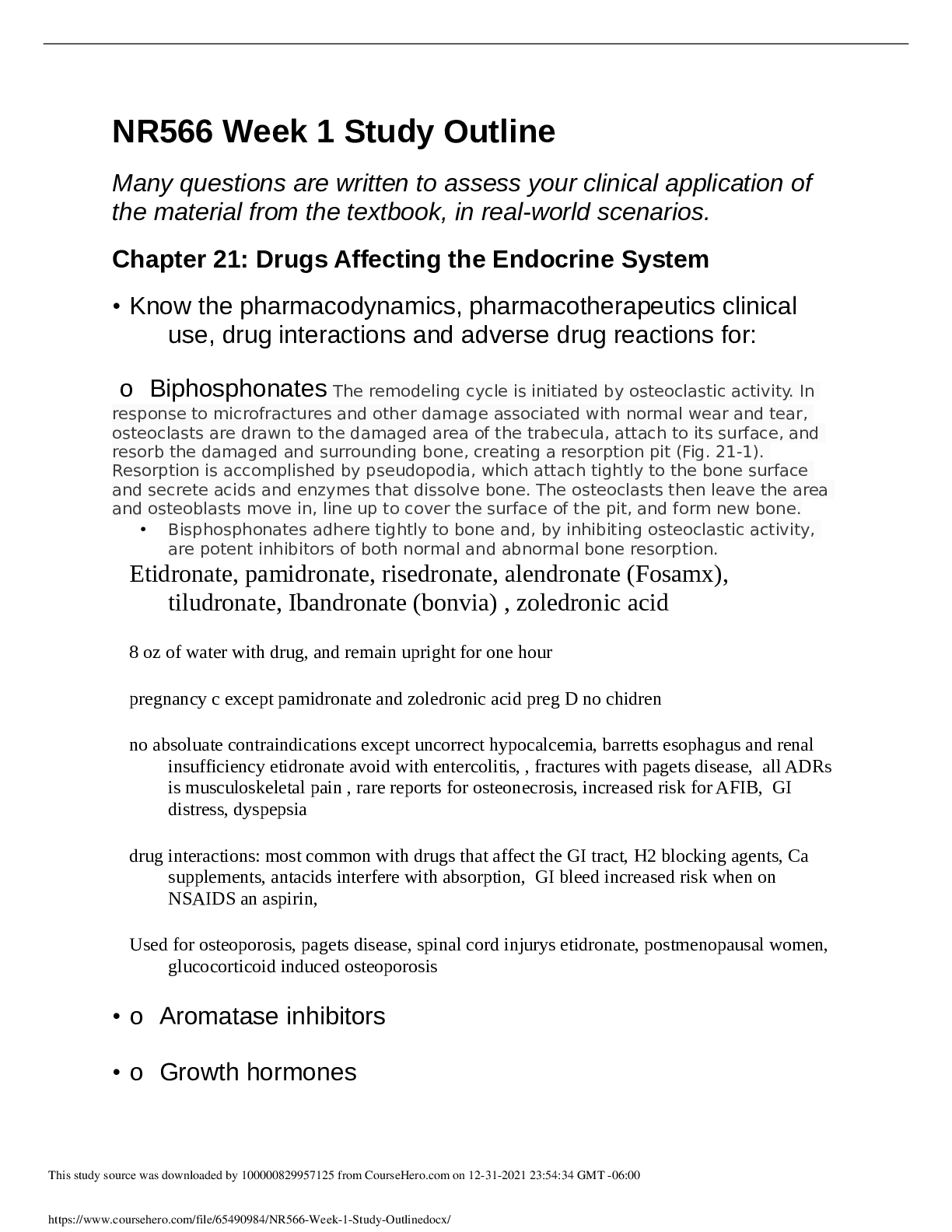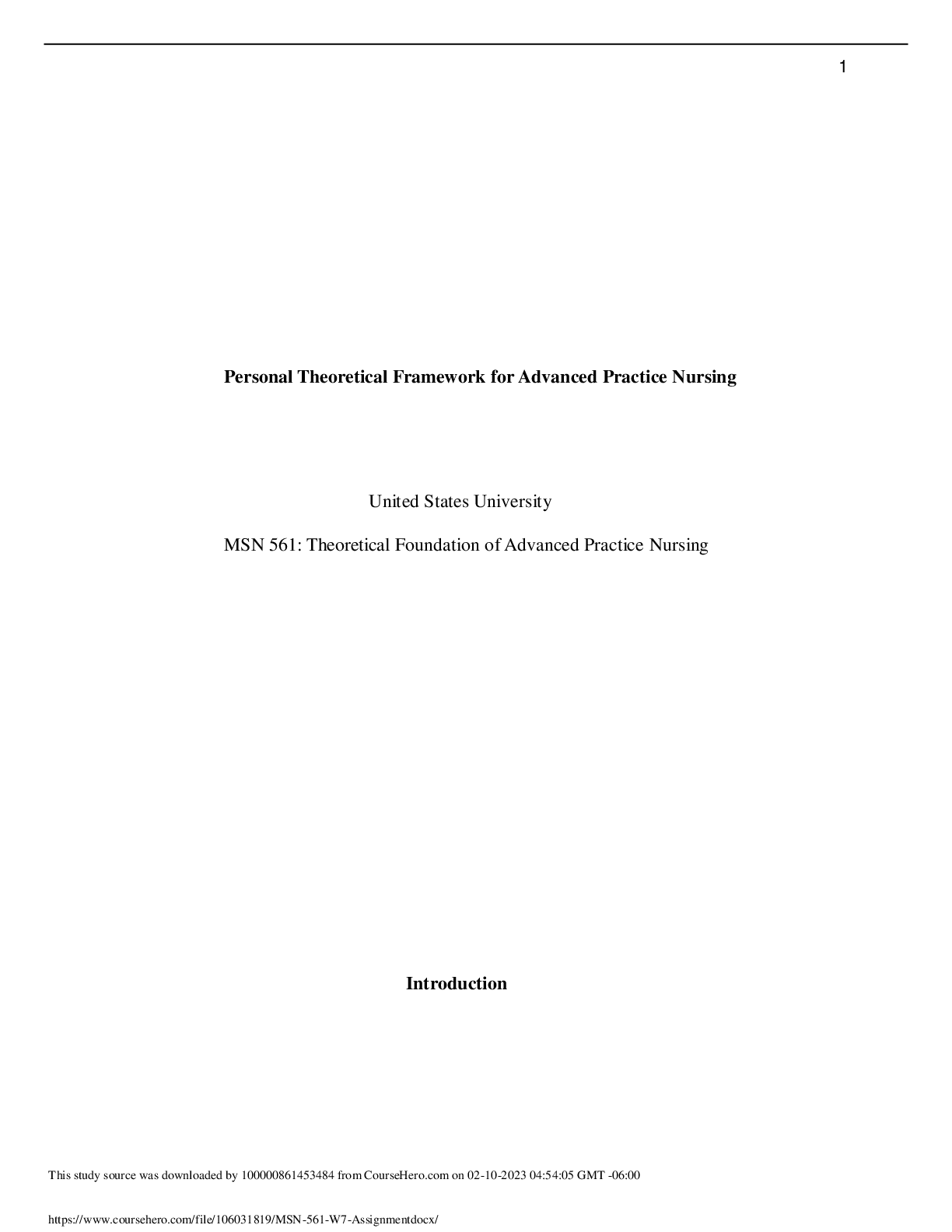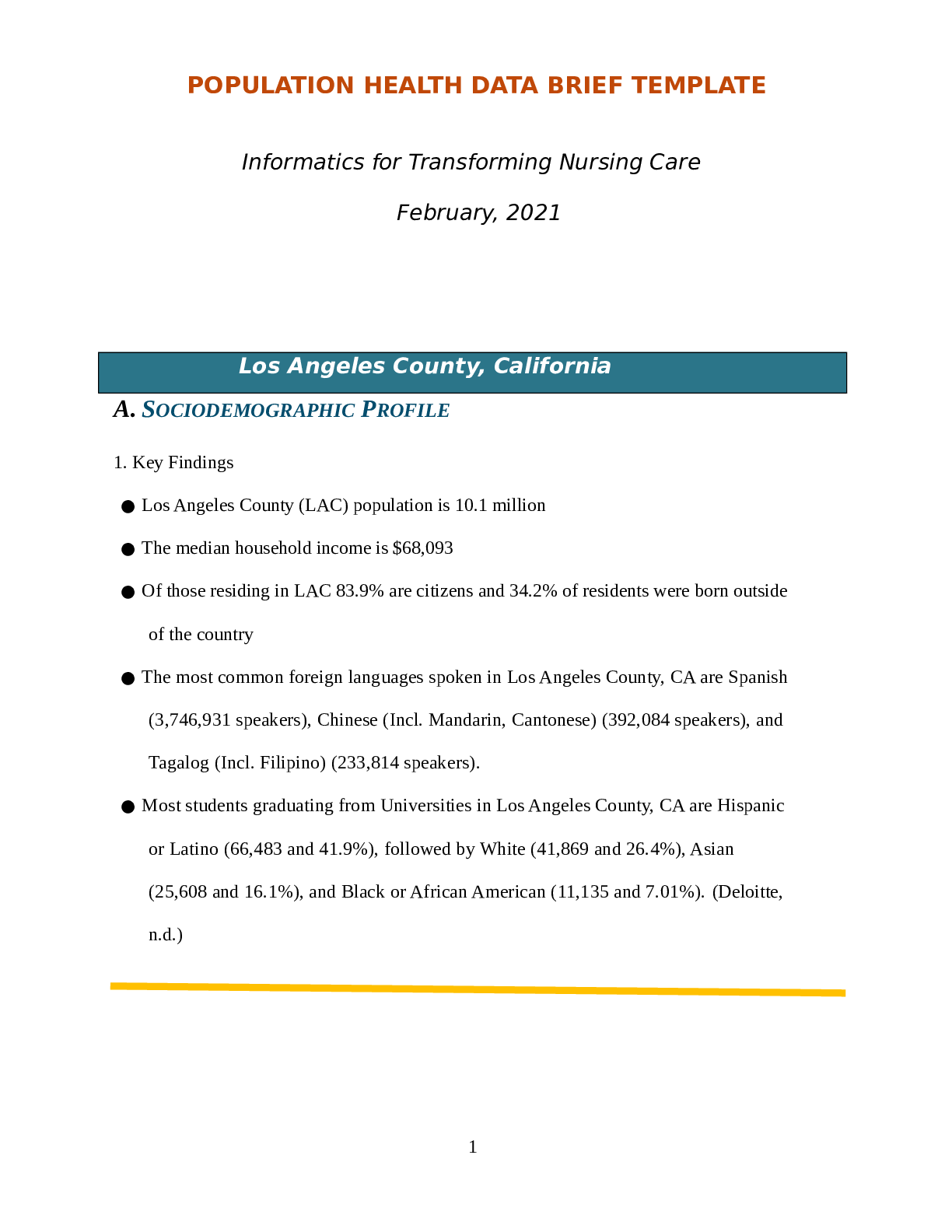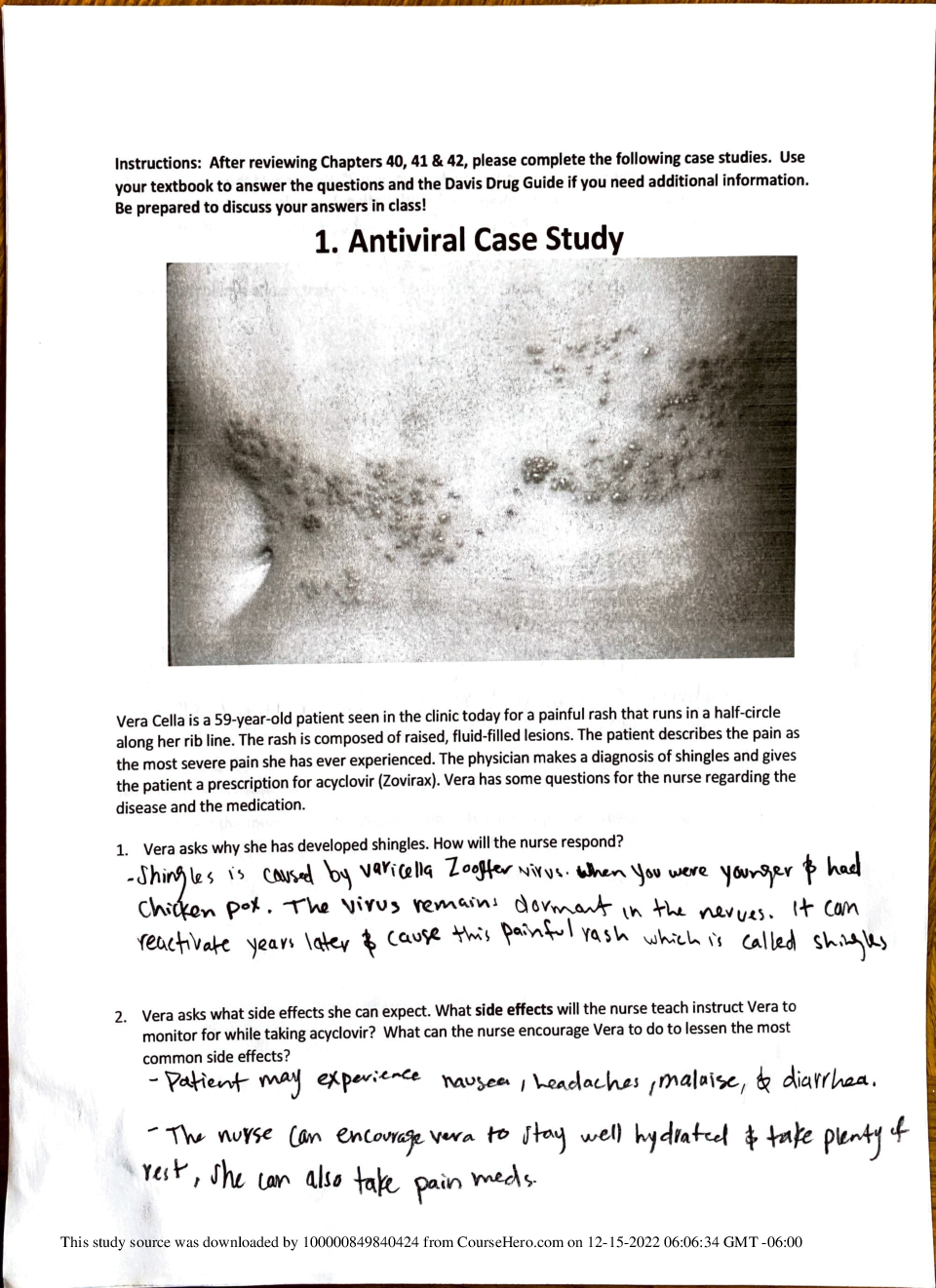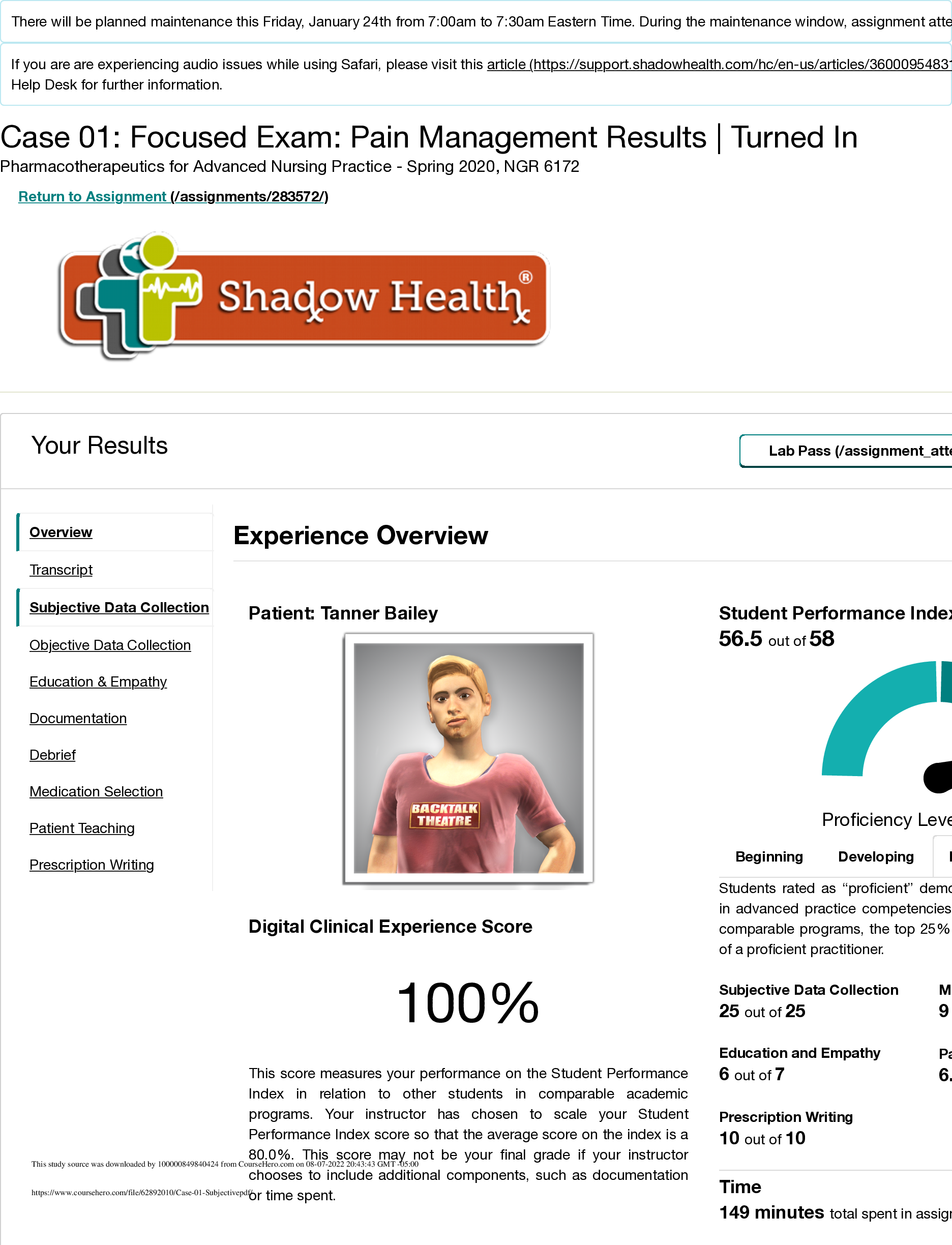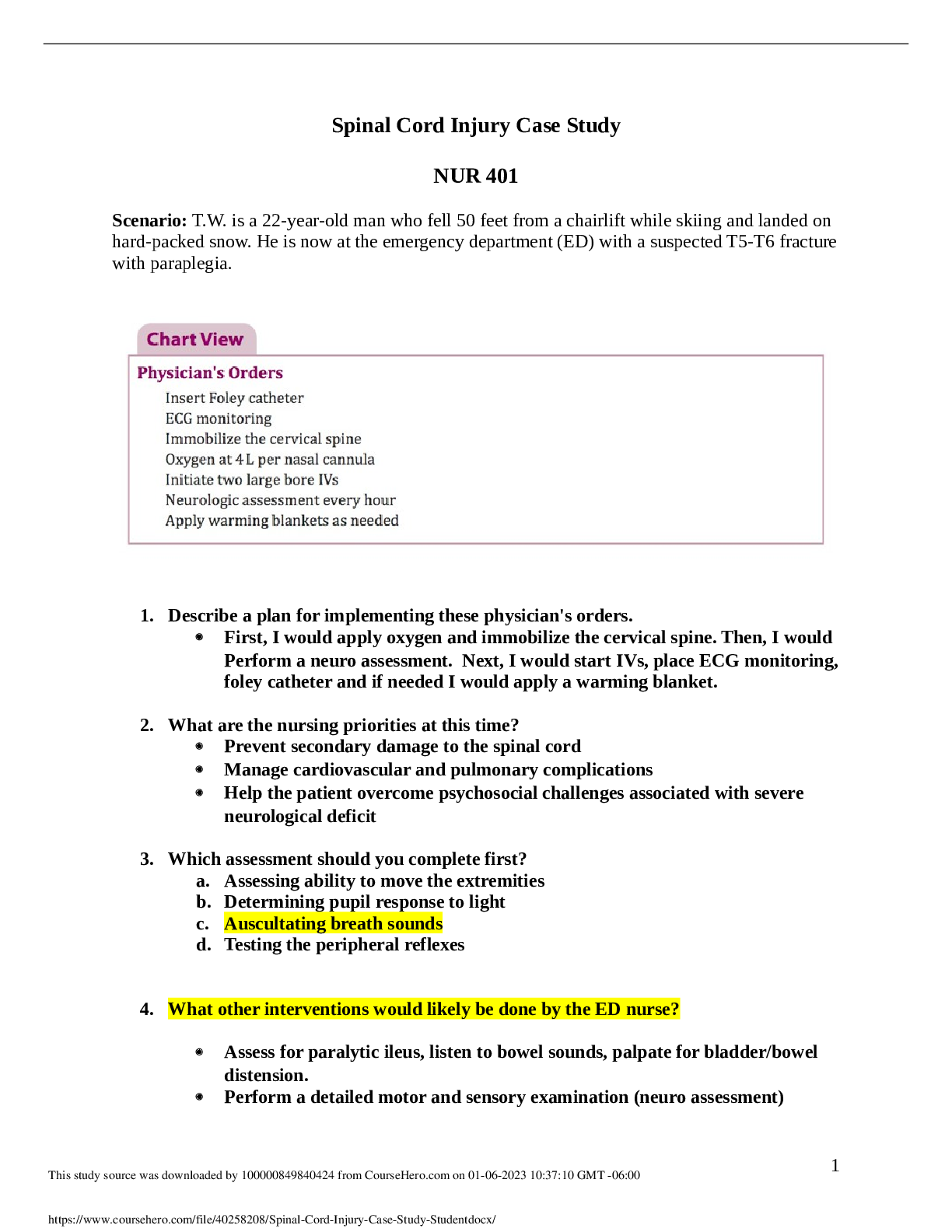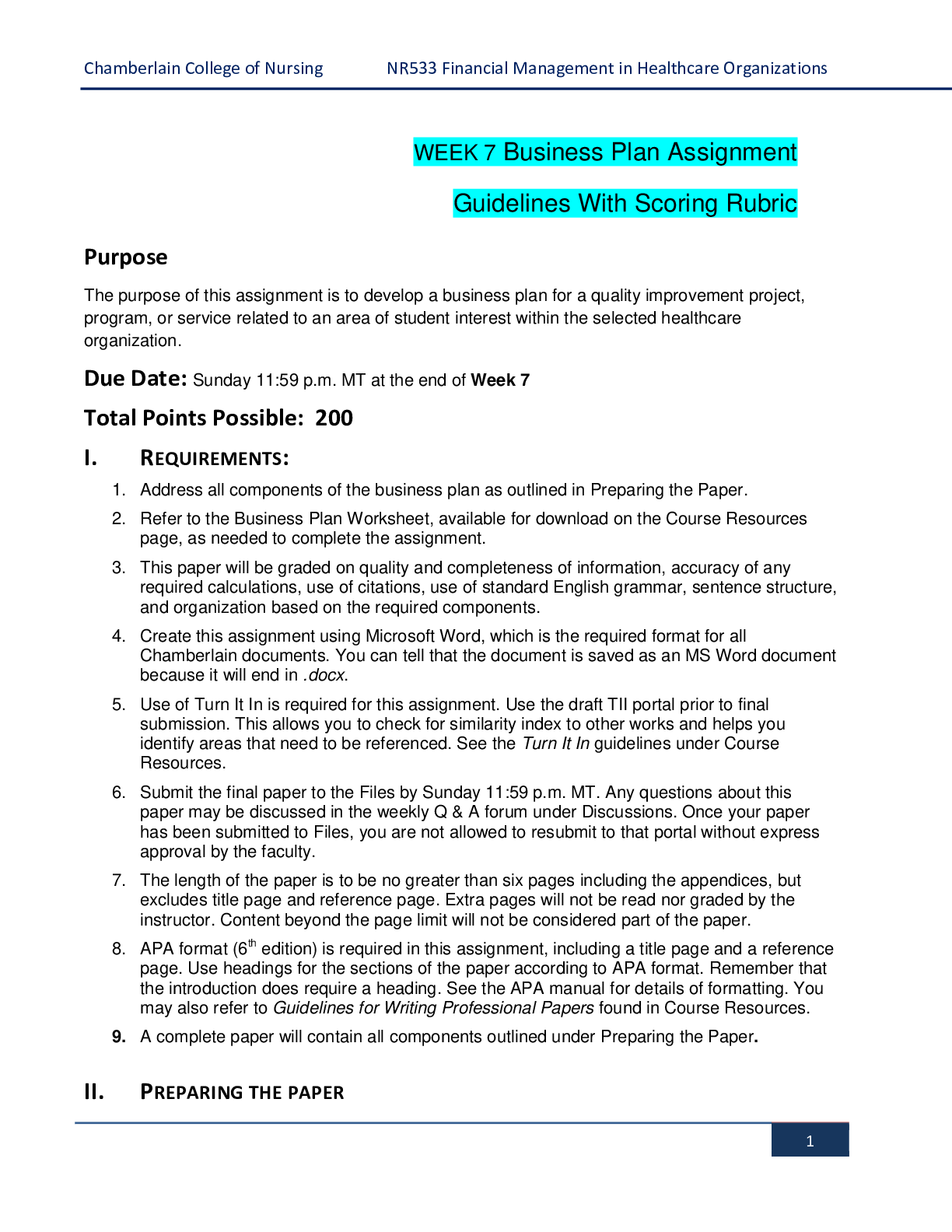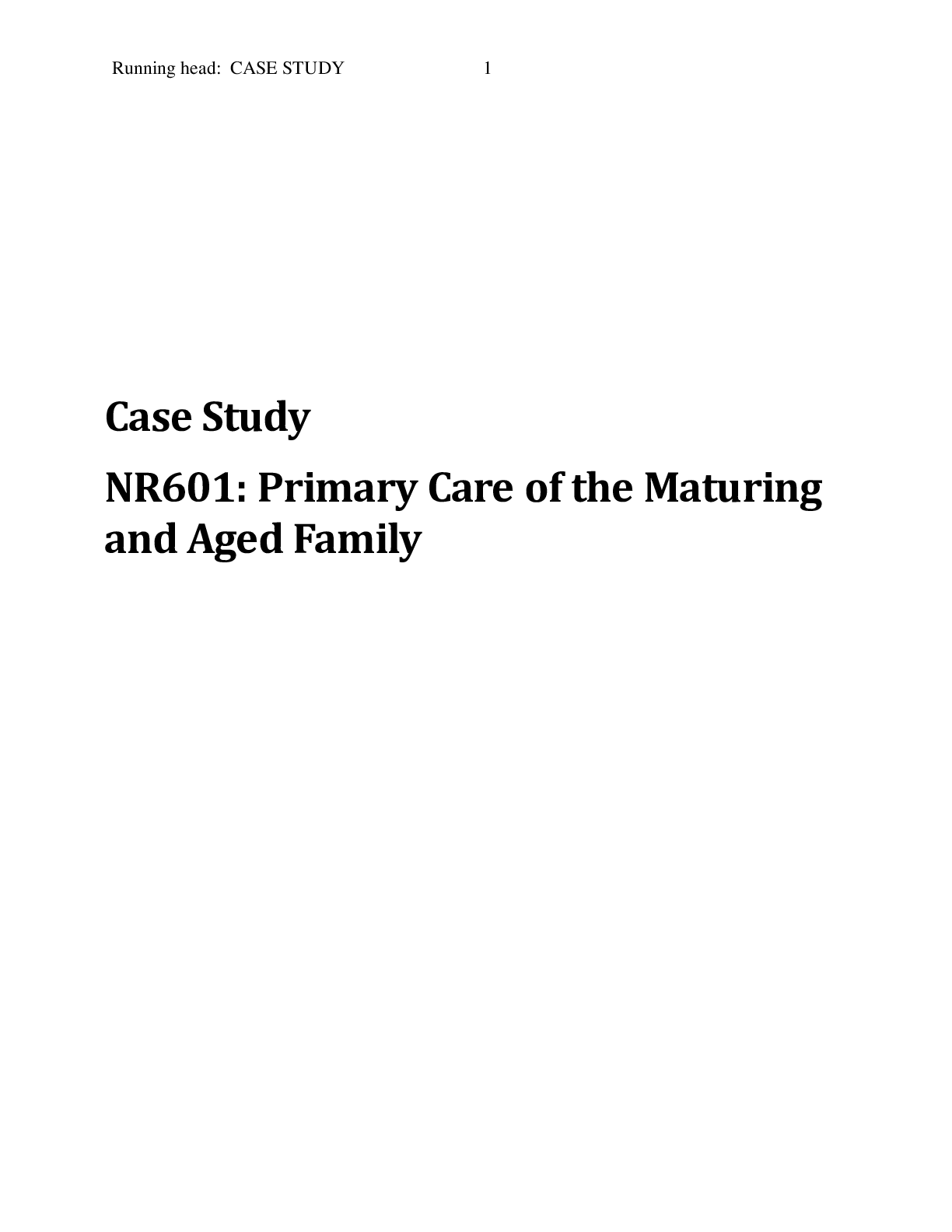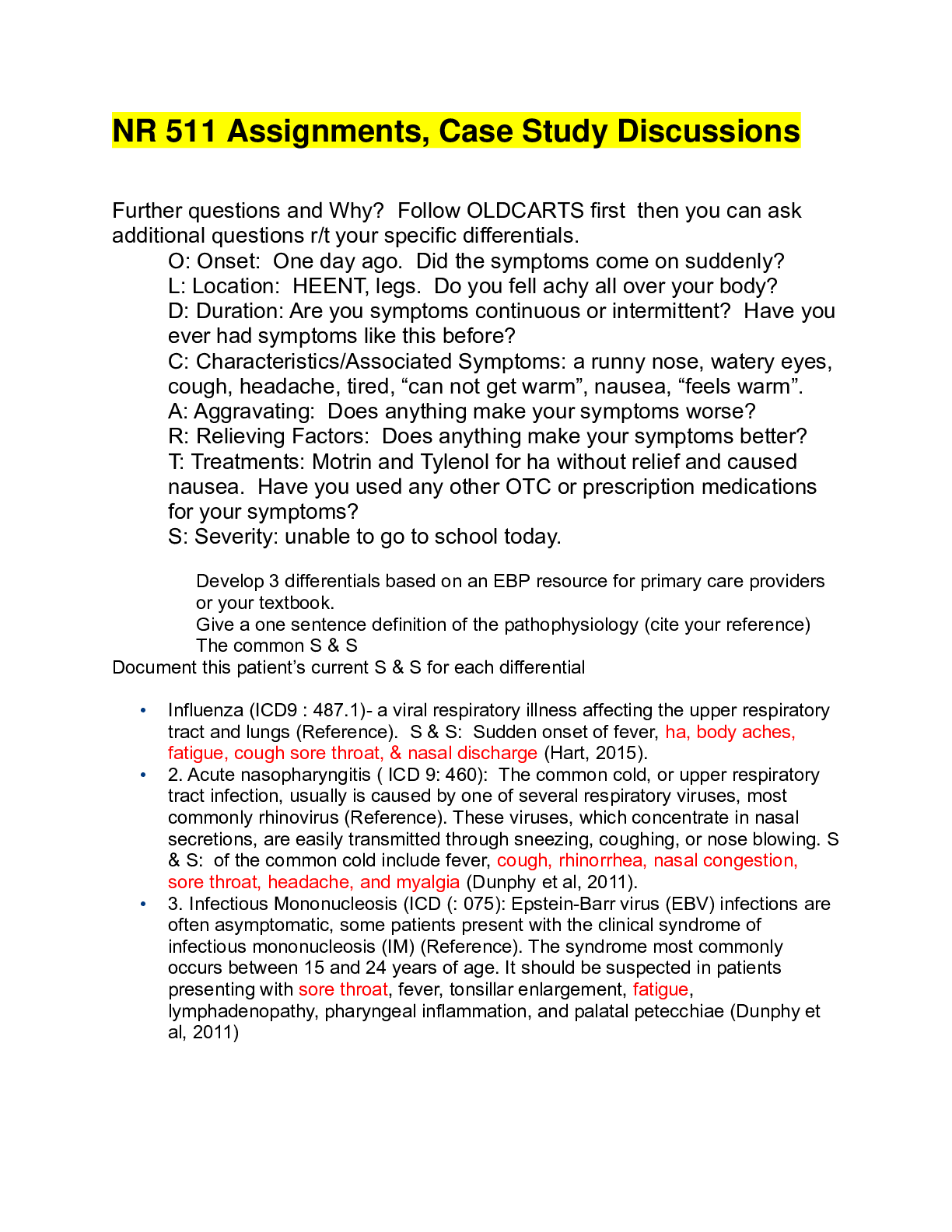*NURSING > CASE STUDY > NR661: APN Capstone Practicum : Capstone Portfolio -Chamberlain College of Nursing {GRADED A+). (All)
NR661: APN Capstone Practicum : Capstone Portfolio -Chamberlain College of Nursing {GRADED A+).
Document Content and Description Below
Capstone Portfolio Chamberlain College of Nursing NR661: APN Capstone Practicum Capstone Portfolio MSN Essential VIII: Clinic... al Prevention and Population Health for Improving Health •Recognizes that the master’s-prepared nurse applies and integrates broad, organizational, client-centered, and culturally appropriate concepts in the planning, delivery, management, and evaluation of evidence-based clinical prevention and population care and services to individuals, families, and aggregates/identified populations. Nurse Practitioner Core Competencies # 1 Scientific Foundation Competencies 1. Critically analyzes data and evidence for improving advanced nursing practice. 2. Integrates knowledge from the humanities and sciences within the context of nursing science. 3. Translates research and other forms of knowledge to improve practice processes and outcomes. 4. Develops new practice approaches based on the integration of research, theory, and practice knowledge. required courses for competency in clinical progr course also exposes one to much more with regar inherent understanding of the causes of diseases a relationship of the mechanisms of an organisms to symptoms of the disease. The need to have a self- correcting investigatory process in clinical acade well addressed since pathophysiology offers a bri between the causes, the mechanisms and the outc different pathogens and diseases. Such link in kno offers a sense of satisfaction and confidence in de with related cases. The course has offered a learni experience on ways to communicate different issu regarding pathophysiology through writing, in ve communication and multimedia. The course has o scientific basis for evaluating whether informatio concerning pathophysiology provided is valid. Th lecture experiences and concepts learnt will also i the success of choices in clinical problem solving course has also underlined the basis of laboratory and the entire diagnostics procedures hence creati correlation between pathophysiology and other he science programs. Most importantly, it helped und in detail how the organ system is interrelated and gives one a basis for a holistic approach toward evaluating and treating patients.Thank you all for session! NR508 Program Outcome #3: Use contemporary communication modalities effectively in advanced nursing roles MSN Essential IX: Master’s- Level Nursing Practice Recognizes that nursing practice, at the master’s level, is broadly defined as any form of nursing intervention that influences healthcare outcomes for individuals, populations, or Professor and Class, Achievement of Course Outcome Two: “Differentiate evidence-based practice guidelines management of therapeutic agents for selected sy problems” gave me the opportunity to incorporate Program Outcome #3 This course has shown me throughout these past 8 weeks and also seeing wit practice as a RN that even though that you provid education at the appointment over the medication systems. Master’s-level nursing graduates must have an advanced level of understanding of nursing and relevant sciences as well as the ability to integrate this knowledge into practice. Nursing practice interventions include both direct and indirect care components. Nurse Practitioner Core Competencies #5 Technology and Information Literacy Competencies 1. Integrates appropriate technologies for knowledge management to improve health care. 2. Translates technical and scientific health information appropriate for various users’ needs. 2a). Assesses the patient’s and caregiver’s educational needs to provide effective, personalized health care. 2b). Coaches the patient and caregiver for positive behavioral change. 3. Demonstrates information literacy skills in complex decision making. 4. Contributes to the design of clinical information systems that promote safe, quality and cost effective care. 5. Uses technology systems that capture data on variables for the evaluation of nursing care. lifestyle changes, the patient doesn’t always reme what was discussed. This is why that it’s vital tha providers use several different types of communic methods. There are a ton of recourses that are not available to us as providers but to the patients as We need to ensure that we provide these informat the patients thus we are providing the patients wit much knowledge as possible. I feel that not only need to provide the information to the patient but providers need to ensure that they completely und their medication and any changes that they need t Achievement of Course Outcome Six: “I information from that course was as foundational future practice as an APN, that it would have been more valuable to have weekly opportunities for classroom lecture. Another resource that I am finding quite valuable Epocrates and MedScape applications on my mob phone. Each of these provides an excellent and e accessible point of quick reference for medication information including: indications, dosage, adver effects, precautions, and critical drug interactions. have been very useful thus far in my clinical expe and I anticipate that I will continue to utilize these references well into my practice after graduation. Achievement of Course Outcome 1: “Ev the APN role for independent and interprofession collaborative management of pharmacological ag prescribing and monitoring pharmacologic therap patients across the lifespan” was heavily depende Nurse Practitioner Core Competency #5: Techn and Information Literacy Competencies. Again, t accessing and use of Epocrates, Micromedex and websites of the like, I was able to practice and app translation of scientific health information, integr technology into health care practice, validate info literacy skills, and use available technology that c data and evaluates care to continue in the improve process. When it comes to prescriptive authority, s critical thinking in decision making is crucial. Medications can and do alter people’s lives and th ability to prescribe them is an awesome responsib Part of the fear in having this responsibility lies in fact that many times, as providers, we do not alwa know what medications a patient is already taking Certainly, patients do their best in relaying their m history and providing up-to-date lists of their curr medications; however, we know that information forgotten or omitted from our conversations with This causes concern when prescribing new medic as there may be harmful drug interactions that we able to avoid without all the pertinent information the patient. Becoming familiar with medication costs and insu issues will certainly continue to be a challenging of pharmacologic authority in my APN practice. Of course, the future of my APN practice will be influenced by daily by pharmacologic aspects. Th influences are broad and will include: safety, cost, effectiveness, accessibility, and practical usage. A progress in my clinical experiences and enter my practice as an APN, I expect that these concerns a decisions will eventually become more and more familiar. However, pharmacology is an area of m that is constantly changing and evolving, so keepi to-date on new medications and indications will b critical. The use of technology is something that I use alm every day as far as my education and practice. I h apps on my phone to look up medications. Also i look where technology is going we now have the availability to have appointments with patients vi computer, or any other way of commination, thro these methods we are able to diagnosis patients w not be able to make to an appointment. This open scholarship, service and global engagement. MSN Essential IX: Master’s-Level Nursing Practice Recognizes that nursing practice, at the master’s level, is broadly defined as any form of nursing intervention that influences healthcare outcomes for individuals, populations, or systems. Master’s-level nursing graduates must have an advanced level of understanding of nursing and relevant sciences as well as the ability to integrate this knowledge into practice. Nursing practice interventions include both direct and indirect care components. NP Core Competencies # 2 Leadership Competencies 1. Assumes complex and advanced leadership roles to initiate and guide change. 2. Provides leadership to foster collaboration with multiple stakeholders (e.g. patients, community, integrated health care teams, and policy makers) to improve health care. 3. Demonstrates leadership that uses critical and reflective thinking. 4. Advocates for improved access, quality and cost effective health care. 5. Advances practice through the development and implementation of innovations incorporating principles of change. 6. Communicates practice knowledge effectively both orally and in writing. 7. Participates in professional organizations and activities that influence advanced practice nursing and/or health outcomes of a population The evolution of the concept and practice of adva nursing has been long and complex. This has led t innovation in the profession, but also to confusion misconceptions about what advanced nursing was and what benefits it could bring to care. Those uncertainties have manifested themselves in differ ways among not only the nursing profession but a patients and the medical and allied health professi What perhaps illustrates the interest in advanced most is the vast literature that has explored its me (Association of Advanced Nursing Practice Educa 2011). For those nurses looking to take their caree next level, pursuing a master of science in nursing (MSN) degree is a surefire way to do so. Commit master's degree program takes dedication, but it c a huge impact on your nursing success in the form new opportunities, from higher pay to greater responsibilities. A master's in nursing program wi you with the skills and advanced training you nee give high-quality nursing care in a specialized rol as nurse practitioner. Earning your MSN qualifies deliver many of the same health care services that physicians are qualified to do, which is particularl important in today's health care field. Physicians have packed schedules or cost too much for some patients making advanced practice nurses a great alternative. Earning an MSN allows you to hone specific area of nursing. While registered nurses d little bit of everything and provide general care, a advanced practice nurse has knowledge about a specialized area of nursing. Another reason to ear MSN is to learn the business side of nursing or if interested in making an impact in the health care industry. A master's degree program will teach yo leadership, management, policies and finance. Ch this route usually means enrolling in a joint MSN program where you'll learn about business or heal administration. Throughout the weeks during this course I have le what my weakness are and strengthens. I have al what I need to focus and those things that I need t improve upon. I also have seen how great it is to to associations that can aid you in finding jobs by focus. networking with other nurses. This class has also my eyes on how different states have some very d variations to the scope of practice for NP’s. I feel need to continue to educate to public on understan what Np’s can do and can’t do. Essential IX describes master’s-level nursing prac the completion of the master’s program in nursing Nursing practice at the master’s level is broadly d as any form of nursing intervention that influence healthcare outcomes for individuals, populations, systems. Master’s-level nursing graduates must h expanded level of understanding of nursing and re sciences built on the Essentials of Baccalaureate Education for Professional Nursing Practice. Mas prepared nurses have developed a deeper understa of the nursing profession based on reflective pract and continue to develop their own plans for lifelo learning and professional development. Nursing-p interventions include both direct and indirect care components. As a practice discipline, clinical care core business of nursing practice whether the grad focused on the provision of care to individuals, population-focused care, administration, informat education or health policy. Master’s nursing educ prepares graduates to implement safe, quality care variety of settings and roles. This Essential includ practice-focused outcomes for all master’s-prepar nurses. Master’s level nursing practice builds upo practice competencies delineated in the Essentials Baccalaureate Education for Professional Nursing Practice (AACN, 2008). Master’s-prepared nurses possess a mastery level of understanding of nursin theory, science and practice. Recent and evolving in health care require integration of key concepts master’s-prepared nursing practice. This includes concepts related to quality improvement, patient s economics of health care, environmental science, epidemiology, genetics/genomics, gerontology, gl healthcare environment and perspectives, health p informatics, organizations and systems, communi negotiation, advocacy, and interprofessional pract Leadership competencies are leadership skills and behaviors that contribute to superior performance using a competency-based approach to leadership 4. Leads practice inquiry, individually or in partnership with others. 5. Disseminates evidence from inquiry to diverse audiences using multiple modalities. 6. Analyzes clinical guidelines for individualized application into practice depression, general the recommendation is to star SSRI but with that patient an SSRI may not be ne the right fight. I am going to try to be the type of practitioner to try the lesser of two evils, if that m sense, I would start on something milder first with counseling and journaling, etc. I feel that someti medication gets over prescribed. I have learned t seeing this through my research through looking u practice, prescribing, guidelines and talking to the providers at my clinical site. I have grown so much through this class and can’ see what the next one has to bring. Thank you all for a wonderful class! NR601 Program Outcome #2: Construct processes for leading and promoting quality improvement and safety in advanced nursing practice and healthcare delivery. MSN Essential II: Organizational and Systems Leadership Recognizes that organizational and systems leadership are critical to the promotion of high quality and safe patient care. Leadership skills are needed that emphasize ethical and critical decision making, effective working relationships, and a systems- perspective. Nurse Practitioner Core Competencies #3 Quality Competencies 1. Uses best available evidence to continuously improve quality of clinical practice. Professor and Class, Program Outcome #2: Construct processes for leading and promoting quality improvement a safety in advanced nursing practice and health delivery. Throughout the last eight weeks I have really lear lot regarding the elderly population and how to tr them. I have learned that you may have to prescri certain medication for this health concern but you watch because it may cause another health concer preceptor taught me the important of using the ex guidelines out there to help with treatment and prescribing modalities. Not only did she teach m but the other providers within the building taught much regarding the elderly population. Current e indicate that approximately80% of people age 65 older have at least 1 chronic illness, such as heart diabetes, orarthritis,1 and that the number of olde with multiple chronic illnesses is substantial. (Sec 2015) 2. Evaluates the relationships among access, cost, quality, and safety and their influence on health care. 3. Evaluates how organizational structure, care processes, financing, marketing and policy decisions impact the quality of health care. 4. Applies skills in peer review to promote a culture of excellence. 5. Anticipates variations in practice and is proactive in implementing interventions to ensure quality. MSN Essential II: Organizational and Systems Leadership Within every organization there is a hierarchy tha be followed. Without it the organizations would f The system works as a kind of checks and balanc system. This helps make sure that errors don’t oc they do they get caught as soon as possible. This makes sure that everyone is held accountable for t own work and actions. Everyone is aware of thei and know is what is required of them. I have seen the practice I have been at the last eight weeks. T work together like a well oil machine and they are big family. I think that it helps that they all get al work so well together. I know that this doesn’t oc in every work environment but it definitely helps. Nurse Practitioner Core Competencies #3 Qua Competencies While in clinicals I have learned the importance o evidence based practice and the most current guid in the care of the patients. EBP is key for all heal professional in order to promote consumer driven evidence based treatment that is supported provisi There are many times that new evidence or new guidelines are coming out and it’s important to sta update on these. One thing that I notice is how th reps come in and inform you on what is new and upcoming with the medications. This is one way helps practitioners to stay up to date with medicat am very thankful to my preceptor she has helped me to what I needed to work on in order to becom stronger nurse practitioner. I believe that this class has helped not only in my confidence as becoming a stronger practitioner bu as a person. I believe I have a better grasp on all outcomes that were set forth in this class. I hope continue to learn and grow as I go on. master’s-prepared nurse, as a member and leader interprofessional teams, communicates, collabora consults with other health professionals to manag coordinate care. As a family nurse practitioner there will be times need to refer our patient to a specialist in order fo the get the best care they deserve. As the primary provider I would keep in close contact with the cl in whom I am referring in order to collaborate a p this particular patient and provide a positive outco For instance, if one my patients was having psychological issues and needed to be referred to counselor for further evaluation, I would want to collaborate with this provider to make sure they a treated medically and psychologically. There are t when a counselor will recommend the patient be s on an antidepressant while going through treatme is where we can collaboratively treat the patient t for an optimal outcome. I think it is important tha providers involved in a patients care take the time update one another. As we know information, dia and medication regimen can be misconstrued by t patient from visit to visit with multiple providers. Nurse Practitioner Core Competencies # 8 Ethics Competencies 1. Integrates ethical principles in decision making 2. Evaluates the ethical consequences of decisions 3. Applies ethically sound solutions to complex is related to individuals, populations and systems of care. As a family practitioner we promote comprehensi in a holistic manner. Many practitioners will expe an array of topics during their clinical encounters different ways the patients perceive their health a ability to cope. An example of these topics includ economic issues, family systems, cultural and soc determinants of wellness (community of origin, immigrant status, occupation, education), and spir As providers it is our role to open the door to conversation and invite our patients to discuss the needs, while refraining from preaching or prescrib spiritual practices, as this is beyond the proper bo the provider-patients relationship. Another examp includes patient with the Jehovah’s Witness tradit tend to refuse blood as a part of their faith and bel times a blood transfusion could be the only way f patient to survive, as a practitioner you must resp faith and values, offering only the understanding consequences of their decision. There are times w providers have few medical solutions for problem cause suffering, chronic pain, grief, domestic viol and broken relationships. In these situations lendi ear, offering community referrals (hospice, palliat care, social services), and providing comfort to ou patients is all we can do Again, thank you all again for a wonderfu challenging, and fulfilling session! Two more to g NR603 Program Outcome #4: Evaluate the design, implementation, and outcomes of strategies developed to meet healthcare needs MSN Essential IV: Translating and Integrating Scholarship into Practice Recognize that the master’s-prepared nurse applies research outcomes within the practice setting, resolves practice problems, works as a change agent, and disseminates results. Nurse Practitioner Core Competencies # 7 Health Delivery System Competencies Professor and Class, Program Outcome #4: Evaluate the design, implementation, and outcomes of strategies de to meet healthcare needs (MSN Essentials) At the family practice where I am doing and have doing my practicum I have an excellent PA, who trauma/flight nurse before becoming a PA. She h taught me to prioritize because the patients that I been seeing have been very complex. I have also a better way of giving a report to say a specialist o another doctor. I have gotten more comfortable w patients and my time with them is being better sp discussing the main problem that we need to conc on. Also, I have gotten quicker with my patients 1. Applies knowledge of organizational practices and complex systems to improve health care delivery. 2. Effects health care change using broad based skills including negotiating, consensus-building, and partnering. 3. Minimizes risk to patients and providers at the individual and systems level. 4. Facilitates the development of health care systems that address the needs of culturally diverse populations, providers, and other stakeholders. 5. Evaluates the impact of health care delivery on patients, providers, other stakeholders, and the environment. 6. Analyzes organizational structure, functions and resources to improve the delivery of care. 7. Collaborates in planning for transitions across the continuum of care. would take me 30-40 minutes before for a 15-mi appointment I have gotten down to the 15-20 min depends on how much the patient wants to talk th I am truly getting more and more comfortable wit plans and diagnosis’, I just have to remember not second guess myself and trust my gut. This is the thing for me to do. MSN Essential IV: Translating and Integrating Scholarship into Practice Recognize that the m prepared nurse applies research outcomes with practice setting, resolves practice problems, wo a change agent, and disseminates results. At the practice, I have gotten to do this quite a bit a newly diagnosed diabetic and she hadn’t been st on a ACE yet and I caught that and I told my prec that she should be taking one and we took the tim educate her the reason that she needed to take it w because of her B/P but because of her diabetes an diabetes causing the restriction of your vessels an will help keep them open. I get to do a lot of edu of patients because it seems that the patients I see very healthy and we are either starting them on ne medication, sending the to a specialist, having the to our diabetic educator or I am trying to provide with information that they need and I have gotten through a couple of them. I only this because I ha them in a follow up appointments. Nurse Practitioner Core Competencies # 7 -He Delivery System Competencies Collaborates in planning for transitions across the continuum of care – This is met by referring to sp as needed, following up with the patient, use of th diabetic educator that we have within the office. Minimizes risk to patients and providers at the ind and systems level – I could meet this competency clinical practice by always keeping my work area always help my elderly patients up and down off t exam table. If I notice a patient is having trouble walking I will grab them a wheel chair or help the back to the checkout area. I always double check orders and medications, making sure I have the ri dosage, right medication to prevent any errors in dispensing. The Changing Role of Advance Nurse Practitioner NR 510 Kandace Wood Chamberlain College of Nursing January 2016 APN Professional Development Plan Introduction Advanced practice nurses or APN’s are nurses that have undertaken master’s degree programs. They are trained together with other medical students with the same course materials, test, examinations, patients’ rounds and other medical experience (Hedges & Williams, 2007). Research studies have shown that the level of training that APNs receive enables them to provide quality services and also administer treatment for chronic illnesses in a cost-effective manner. In some cases, it has been noted that APNs are as competent as doctors in the management of diseases such as endoscopic screening for cancer treatment (Hedges & Williams, 2007). In addition, studies have shown that certified nurse-midwives were able to safely manage normal pregnancies at the same level or sometimes better than that of medical doctors. APNs have led to the development of new roles such as the nurse practitioner, the certified nurse midwife, the clinical nurse specialist and certified registered nurse anesthetists. APN Scope of Practice Most APNs have received additional training either at masters or doctoral level or in some cases diploma certificates after additional medical training for up to 2 years. Unfortunately, society has not provided adequate opportunities for APN nurses for a number of reasons. One of the reasons often cited is in regard to quality issues. One of the argument put forward states that there is no sufficient basis in the fact that APN nurses that practice on their own can provide medical services of the same quality or better that doctors. Organized medicine has therefore not acknowledge APNs and therefore they find themselves performing the same roles even after completing advanced medical studies at the masters and doctoral level. Evidence also shows that although APNs provide a broad range of medical services, APNs are constrained by a laws and legislations that are restrictive. As a results of these laws and regulations, research on the effectiveness of independent APNs has been controlled. The evidence is in, if organized medicine chooses to acknowledge it. But despite their ability to provide a broad range of health services independently, nurse practitioners, for example, are The issue of quality of care has been subject of controversy amongst medical practitioners. Quality of care is measured by both tangible and intangible aspects. It has therefore been found to be difficult to measure the quality of care of APNs in comparison to the services of medical. The advancement of training of nurses has cause rivalry between doctors and APNs and in most cases APN nurses have failed to obtain the necessary opportunities to practice the advanced skills obtained. Several states specify that medical doctors should supervise that work of APNs. While the curriculum for APNs and medical doctors is the same and in most case medical school curriculum does not include nutritional , minor illness management and patient teaching, it therefore demean APNs when physicians have to supervise them. In addition, APNs have a challenge when it comes to getting credentials for the further medical training that they have received (Fitzpatrick, 2003). In most public institutions, the master’s and doctoral degrees are often not recognized and they end up performing the nurse role even after advancing in their career. Personal Assessment As a nurse who has been practicing for three years I would considered myself to be in the stage three on Patricia Benner’s Theory from Novice to Expert. This stage is called the competent RN. I am more aware of long-term goals and have gained perspective from planning own actions based on conscious, abstract, and analytical thinking and helps to achieve greater efficiency and organization. The competent stage is the most pivotal in clinical learning because the learner must begin to recognize patterns and determine which elements of the situation warrant attention and which can be ignored. The competent nurse devises new rules and reasoning procedures for a plan while applying learned rules for action on the basis of the relevant facts of that situation. My strengthens include being able to a quick decision on what needs to be done, etc., being organized in what needs to be done and when it needs to be done. A weakness of mine would have to be at times I still want to second guess myself but once I have ran it be the physician and they reassure that my thinking is on the right path I do feel better about my choices but still always second guessing. As I continue in my development of an expert nurse these skills will not only grow and improve but will have more advance skills that are added to these. Networking and Marketing Strategies For NPs’ to collaboratively provide comprehensive primary health care, they must understand and develop negotiating skills. Positive working relationships with health professionals, organizations, and clients require role negotiation, particularly when few guidelines exist for a role or a role is new and undeveloped. NPs’ need to assess the internal politics of the organization as part of their role negotiation. Networking is another necessary skill. Forums, joint conferences, collaborative practice, and research provide opportunities to expand their functions Marketing strategies should be designed to project an image that shows a nurse’s individual achievement. In assessing and analyzing the needs of target markets, nurses must consider professional, institutional, and the target client groups’ goals. Methods of obtaining positions and negotiating future roles include providing portfolios of credentialed documents and samples of professional accomplishments such as audiovisual materials, program plans and evaluations conducted, client education packets, and history and physical assessment tools developed. Portfolios are folders that contain all of these documents to showcase the nurse’s abilities. NPs’ should keep current portfolios containing examples of their professional activities. Names, addresses, and telephone numbers of professional and personal references should be furnished in the portfolios (but only after the referring persons have granted permission). A new application that can assist in keeping current portfolios is an electronic portfolio or e-portfolio where information is housed on the internet that can be easily updated and shared/ transmitted to employers and others. The 4P's of marketing - An approach to promote the role of the APN Product - relates to what type of services are provided and what makes it unique. Place - where are the services located? What are the office hours? Are you available after hours? Is there a website? Price? What are the fees? Is insurance accepted? And Are there any discounts? Promotion - How will you advertise? Is there public education? Referrals. Partnering - Collaboration of heath care colleagues. Effective marketing promoting the role of the APN to the public and potential employers is essential in the delivery of cost efficient healthcare and positive outcomes. Expanding marketing the role development of the Doctorate Nurse Practitioner includes: Healthcare system structures, Outcomes to influence policy, Provide leadership, improve outcome within the health care environment, and Continuing marketing of the master prepared APN. The Goal is to educate the community, other professions, and the industry about the APN role, scope of practice and to sell a service or product that would satisfy the needs of the consumer-patient. APN's are unique and expert health care providers of acute, primary, and chronic illness. Conclusion The lack of recognition and career development prospects is likely to discourage the development of the APN role. This is due to the fact that even when nurses receive additional raining, they to a large extend find themselves in the same role which affects their morale (Advanced practice nurses APN, 2003). When one receive additional training in their field, one of the expectations that one has is promotion, pay increase and general career development. However, for the case of APNs, development has been a challenge. Becoming a nurse practitioner requires knowledge above that of the registered nurse, but few of us considered elements such as marketing, contracts, and reimbursement as a need for caring for patients. Understanding how to market oneself to a potential employer may be considered difficult for most new nurse practitioners. This is due to the fact that most of us have found it very easy to acquire a position as a registered nurse. Contractual agreements may be very elusive to the new nurse practitioner as during their professional career as a registered nurse contracts with employers are as easy as the willingness to accept a position. As we have all put forth the effort to become nurse practitioners salary becomes a starting point for entering into a contractual agreement with a potential employer. Opportunities for the new nurse practitioner are vast, but the potential to undermine oneself by poor preparation while entering into a contractual agreement with a potential employer is a real possibility. Educating oneself on the value of their profession prior to entering into any agreement with an employer is of utmost importance. References: Advanced practice nurses APN. (2003). Washington, D.C.: [Dept. of Veterans Affairs, Veterans Health Administration?]. Association of Community Health Nursing Educators: Disaster preparedness white paper for community/ public health nursing educators, Latham, NY, 2008, ACHNE. Association of Community Health Nursing Educators: Graduate education for advanced practice in community/public health nursing: at the crossroads, Latham, NY, 2007, ACHNE. Fitzpatrick, J. (2003). Managing your practice a guide for advanced practice nurses. New York: Springer Pub. Hedges, C., & Williams, B. (2007.). Anatomy of research for nurses. Kandace Wood • 705 S Park Ave Manito Il 61546 • 309-840-2171 • [email protected] SUMMARY OF QUALIFICATIONS Professional, adaptable, and motivated Family Nurse Practitioner-student. Five years of experience working with doctors, nurse practitioners, physician assistants, nurses, families, occupational therapists, dieticians, and other ancillary staff to provide complex, patient centered care. Advocates for being the best provider possible for each patient, which means: Commitment to life long learning, applying evidence based practice, working with a team cohesively, functioning independently as required, including the patient and family in care, and maintaining the integrity of health care practices. Currently concluding clinical hours to meet graduation requirements by June 21, 2017. EDUCATION Chamberlain College of Nursing Masters of Science in Nursing-FNP 2017 Methodist College of Nursing Bachelors of Science in Nursing 2012 Illinois Central College Associates Degree in General Education 2011 CLINICAL EXPERIENCE, PRECEPTED ICPR – Pekin, IL Preceptor: Tonya Dennison, FNP 250 Hours Harrington OB GYN- Pekin, IL Preceptor: Douglas Harrington, MD 125 Hours Preceptor: Christy Enright, CNM ICPR -Pekin IL Preceptor: Volkan Sumer, DO Preceptor: Victoria Styninger, PA 250 Hours Experiences in management of primary care, Family Practice: • Common diagnoses/exam focuses encountered include: Annual physical exam (newborn to elderly), well-woman exams, well-men exams, vaccinations, hypertension, hyperlipidemia, diabetes type II, hypothyroidism, gout, lower back pain, insomnia, anxiety, depression, acute sinusitis, acute pharyngitis, bronchitis, gastroenteritis, influenza, urinary tract infections, prostatitis, etc. • Established a process for obtaining a history, performing physical exams, diagnosing and treating current conditions, and developing management plans for chronic disorders. • Hands on experience in obtaining and interpreting urinalysis, rapid strep, and rapid influenza. • Gained additional experience working with a wide variety of people of various ages, cultures, ethnicities, and socioeconomic backgrounds. PROFESSIONAL EXPERIENCE Midwest Central District #191 2016-current • School Nurse Midwest Central District #191 2015-2016 • Substitute teacher Accurate Home Care, August 2014-2016 • Caring for special needs children with a ventilator • Dede 309-691-5011 America Red Cross, April 2014-August 2014 • Collections specialist-apheresis • Supervisor Cyndi Ambrosch 309-677-7272 Pekin Manor, August 2013-March 2014 • RN-BSN/Charge Nurse • Contact: Heather Fredrick DON 309-202-3387 Unity Point Health Methodist, February 2013-August ▪ RN-BSN Cardiac Step down Unit Hawks Grove INN, 2008-2010 ▪ Waitress Forman Ambulance, 2000-2006 ▪ EMT-BD, respond to emergency calls, stabilize the patient and transport to the hospital Wal-Mart, 2004-2007 ▪ Sales Associate ▪ Cashier ▪ ICS team responsible for stocking shelves Parkview Retirement Home 2000-2004, no longer in business ▪ Assistant Manager, help make schedules, on-call for call offs ▪ Cooking meals, cleaning, laundry, assisting residents with any needs they may have . PROFESSIONAL MEMBERSHIPS American Nurses Association 2012-Present Illinois Nurses Association 2012-Present HONORS/AWARDS Sigma Theta Tau International Nursing Honor society 2017 LICENSURE/CERTIFICATIONS Registered Nurse, State of Ilinois(RN 041408547) 2013-Present BLS for Healthcare Providers 2000-Present K. F., 37 y.o. female S. CC. Well Women Exam HPI: Kayla reports that she is healthy and takes no medication. She has no symptoms that she can think of other than she is currently having trouble falling and staying asleep, but associates this with stress and with sleeping in the same room with her two younger children. She is a 15-year smoker of 1PPD up until 18 months ago when she quit with the pregnancy of Riley. She is concerned about finances today and reports ongoing fatigue. She has not and menses since the birth of her last child. She is not currently sexually active with men, women, or both and has been abstinent for the last 6 months. PMH: Kayla denies any past medical history other than four pregnancies, three births, one pre-term, and two C-sections with the last two births. She had one miscarriage at 10 weeks when she was 16. She also reports that she had PCOS as a teenager and has always had irregular menses. She had gestational diabetes with the last birth and preeclampsia causing the early delivery of Riley. Current Medications: She is currently taking Advil PM every night to sleep Surgeries: Denies any surgeries except two C-sections. Allergies: She has no allergies. Vaccine History: Unknown. When was you last flu vaccine? Social History: She is a 15-year smoker of 1PPD up until 18 months ago. Drinks a glass of wine at night. She does not routinely exercise. She often skips breakfast and lunch and eats whatever the children eat for dinner, which is often processed, or quick food. Family History: Kayla’s mother has a history of hyperlipidemia, Type 2 DM, glaucoma, breast cancer at age 50 treated with lumpectomy, and Hypertension. She is Latin American in descent, emigrating from Cuba in the 1970s. Kayla’s father has a history of hypertension, hyperlipidemia, and an MI with stenting 5 years ago. The mother has two siblings; a younger brother in the U.S. Navy, and an older sister who is 42 and lives in a large urban city in the Midwest with her family, and she is in good health. Other family members died of old age. She is unaware of paternal familial health history. ROS: Constitutional- Reports ongoing fatigue, trouble falling asleep and staying asleep. HEENT- Not reported Skin- Not reported Cardiovascular- Not reported Respiratory- Not reported Gastrointestinal- Not reported Genitourinary- Not reported Neurological- Not reported Musculoskeletal- Not reported Hematological- Not reported Lymphatics- Not reported Psychiatric- Not reported Endocrine- Not reported O. V/S: Height: 155cm, Weight: 65.5 kg. B/P: 130/76, HR: 82, T: 98.7, Resp: 16, SpO2: 97%, BMI- 27.3 General: Awake, alert, appropriate; well groomed; tearful at times throughout the exam; skin: warm, dry, intact; HEENT: head normocephalic; Conjunctiva clear, non-icteric, PERRLA, EOM’s intact; tympanic membranes intact, unremarkable; nares patent, unremarkable bil; pharynx unremarkable tonsils 2/4 bil; neck supple w/o lymphadenopathy. Cardiopulmonary: Heart RRR w/o murmur; lungs CTA throughout; respirations even and unlabored. Breast Exam: Breasts of normal development bil. Areola unremarkable. Nipples without discharge or tenderness. No masses or tenderness upon palpation Abdomen: abdomen, soft, with normoactive bowel sounds throughout; tenderness to palpation in the super-pubic area; no masses or organomegally; peripheral pulses reg., equal External Genitalia: Mons intact with normal hair distribution, labia majora, minora, clitoris intact, Bartholin’s and Skene’s glands. Intact. No piercings. No hymen. Vagina: Pink, moist, with rugae, no odor, tone good. No rectocele, cystocele, or discharge. Cervix: pink with multi-parous patent os, no lesions, sl. anterior and freely mobile without tenderness. Uterus: retrograde, small firm, midline, smooth, mobile, non-tender uterus., size, consistency, mobility. Adnexae: present, smooth, non- tender. Diagnostic tests- Urinalysis in the office: Cloudy amber yellow urine, Sp. Gr. 1.010, negative WBCs, nitrites, and leukoesterase, RBCs, glucose, and ketones. Primary Diagnosis: Well Visit Exam (Z00.00) The patient presents to the clinic today for a Wellness exam. Secondary Diagnoses: Depression (V79.0) - Feelings of low self-esteem, sadness, anxiety or worthlessness. Depression can cause poor appetite, insomnia, low energy or fatigue, and low self-esteem. The patient has been tearful during her visit today. Adjustment insomnia (F51.02) - Transient episodes of insomnia induced by changes in one’s life due to recent or ongoing changes or adjustments. Kayla is most likely experiencing adjustment insomnia due to all the new changes including living situation and financial strain. She is drinking a glass of wine each night and taking an Advil PM just to sleep. Polycystic ovarian syndrome (E28.2) – The patient reports a history of polycystic ovarian syndrome and irregular menses. P. Diagnostics, Screenings, and Preventative actions: Additional tests- Seeing that this is her annual exam I would want to do routine labs. Serum HCG, CBC, CMP, TSH, ferritin, folate, total iron binding capacity with iron, reticulocyte count, vitamin B, and folic acid (due to her fatigue), A1C, Lipid profile, thin prep pap cytology and HPV DNA 16, 18 screening. The North Carolina Family Assessment Scales would be suitable for assessment of this family. This tool measures family functioning from the perspective of the person most involved in the family. The tool looks at environment, parental capability, family interactions, family safety, and child well-being. The patient health questionnaire (PHQ) - Depression is common and can be due to stressful life events. Depression is often reversible with early recognition and proper treatment. This is a short 9 item scale that assesses the patient’s symptoms, functional impairment and includes a section that establishes a severity score. Breasts (clinical breast examination every 1-3 years beginning at age 20) Pelvic examination: ages 19-20 years when indicated by the medical history; age 21 or older, periodic pelvic examination Vaccine screening/verification: Influenza 1 dose annually, dependent on the time of year. Tdap booster if indicated (every 10 years). If not received already, both of these vaccines would be recommended Rx- Escitalopram 10 mg tablet Sig: 1 tablet PO QD Disp: 30, refills 5 Education: Call the office if you start having fever, chills, nausea or vomiting. Increase your fluid intake and sustain from any carbonated or caffeinated beverages until your urinary tract infection resolves. Wear cotton underwear, practice good hygiene and take your antibiotics until they are all gone. Go to the emergency room if you are having any thoughts of hurting yourself or others. A counselor is encouraged for therapy; this is a third party person you can talk to about the stresses in your life. The counselor can also assist you with referrals and community services you may need. Make sure your diet contains a variety of foods, particularly whole grains, fruits, and vegetables. Food and drinks containing caffeine, saturated fats, trans-fatty acids and cholesterol should be limited. You should also partake in regular exercise, at least 30-60 minutes a day 3-4 days a week. Studies revealed women that follow these guidelines have lower rates of morbidity and mortality from coronary artery disease and certain forms of cancer. Referral: Case management consults to assist in community referrals for healthcare and financial assistance. Follow up: In office in 2 weeks to follow up on depression. Call the office if you have any problems or concerns. HPI: C.G. is a 69-year-old male with a history of right head and neck cancer. His cancer was diagnosed 2 years ago at which point he decided to stop smoking Onset: 2 years ago Location: head and neck, left lingual tonsil region Duration: Ongoing, 2 year Characteristics: supple neck, limited ROM to neck, rhonchi in anterior chest bilateral, metabolic activity in the left lymph node area along with other regions of abnormal metabolic activity in the body, RUQ tenderness Aggravating Factors: Tiredness from chemotherapy and radiation, oral mucosa irritated-stomatitis. Relieving factors: unknown Treatment: 6 weeks of radiation and chemotherapy, right radical neck dissection, 2012. Severity: liver and the lungs metastasis Current medications: Carvedilol 12.5 mg po 1 daily Furosemide 40 mg po daily Allergies: no known drug allergies. PMHx, Hypertension Hyperlipidemia Stomatitis Anemia Neutropenia Surgeries: right radical neck dissection , 2012 Vaccination history include: Influenza vaccine last received 1 year ago Received pneumovax at age 65 Received Tdap 5 years ago Has not had the herpes zoster vaccine Social history and Risk Factors: Former smoker-stopped smoking at the time his cancer was diagnosed-2 years ago Negative for alcohol intake or drug use Patient does not have an advanced directive or living will. He is refusing further treatment for his cancer and his wife and children are in disagreement with him. The patient wants to know what his options are for the remainder of his life. Family Hx : unknown ROS Constitutional symptoms – denies fever and chills, denies significant weight loss or weight gain. HEENT: denies any visual loss, blurred vision, and double vision. No drainage or exudate in ears. No hearing loss, no sneezing, congestion and runny nose, no sore throat. Denies any nasal issues. Cardiovascular – denies syncope, denies chest pain. Pulmonary – denies hemoptysis, no labored respirations, no cough, : rhonchi in anterior chest bilaterally. Gastrointestinal – denies nausea, vomiting, or diarrhea. RUQ tenderness; liver palpable Musculoskeletal –denies crepitus, No muscle atrophy or asymmetry, no joint discomfort Genitourinary: denies urine frequency, or bladder problem, Neurological – denies headaches, dizziness, or lightheadedness. Psychiatry: Alert and oriented O: Vital Signs: Height: 6’0 Weight: 140 pounds; BMI: 19.0 BP: 156/84 P: 84 regular R: 20 Physical Exam HEENT: normocephalic, symmetric PERRLA, EOMI; poor dentition NECK: left neck supple; non-palpable lymph nodes; no carotid bruits. Limited ROM LUNGS: rhonchi in anterior chest bilaterally. HEART: S1 and S2 audible; regular rate and rhythm ABDOMEN: active bowel sounds all 4 quadrants; Normal contour; RUQ tenderness; liver palpable NEUROLOGIC: negative GENITOURINARY: negative MUSCULOSKELETAL: negative PSYCH: PHQ-9 is 15 SKIN: oral mucosa irritated-stomatitis A. Primary Diagnosis Encounter for Palliative Care ICD 10 Z51.5. In the final stages of many terminal illnesses, care priorities tend to shift. Instead of ongoing curative measures, the focus often changes to palliative care for the relief of pain, symptoms, and emotional stress Hospice is typically an option for patients whose life expectancy is six months or less, and involves palliative care (pain and symptom relief) to enable loved ones to live his or her final days with the highest quality of life possible. Hospice care can be provided onsite at some hospitals, nursing homes, and other health care facilities, although in most cases hospice is provided in the patient’s own home A hospice team provides emotional and spiritual support according to the wishes and beliefs of the patient. They also offer emotional support to the patient’s family, caregivers, and loved ones, including grief counseling Oropharyngeal cancer (ICD 10 C10.9) is a disease in which malignant (cancer) cells form in the tissues of the oropharynx. Smoking or being infected with human papillomavirus can increase the risk of oropharyngeal cancer Symptoms of oropharyngeal cancer include A lump in the back of the mouth, throat, or neck, a sore throat that does not go away, trouble swallowing, trouble opening the mouth fully, trouble moving the tongue, weight loss for no known reason,ear pain, a change in voice, coughing up blood. Elderly Depression (ICD 10 F32.9): Intense feelings of sadness and other symptoms, like losing interest in things that one enjoys to do, may last for a while. Physical complaints, such as arthritis pain or worsening headaches, are often the major symptom of depression in the elderly. Sleep problems, fatigue and exhaustion, irritability, loss of self-regard, social withdrawal, physical pain, digestive problems(nausea, indigestion, diarrhea, or constipation), eating disorders, weight gain or loss are some signs of depression. C.G score on PHQ-9 is 15 P: Plan I will perform a very comprehensive history and physical exam, medical history, and order very limited diagnostic tests. The exams and tests may vary depending on the symptoms. I will assess and reconcile medications and ensure that C.G’s HTN is controlled, provide comfort, make appropriate referrals, and to help him transition to end of life care. Diagnostics Nutrition studies: Albumin and transferrin serum levels are important to establish nutritional status. Studies of renal and hepatic function (Marsden, 2014) to determine the degree of cancer metastasis CBC counts: May be normal in early-stage disease; in more advanced stages, may demonstrate anemia, thrombocytopenia/leukopenia/pancytopenia, lymphocytosis, thrombocytosis Serum chemistry studies: May show elevated LDH and calcium levels, abnormal liver function tests Ultrasound is a quick and inexpensive way to get information about disease that is in lymph nodes in the neck To be determined by oncologist and if patient wishes to undergo CT Scan: This is a quick series of X-rays that can show very good detail of the anatomy. It is helpful in seeing the extent of the main tumor mass and what structures it has invaded. It can also help detect spread into the neck MRI shows more subtle details of how extensive the main tumor mass is. It can also help pick up spread of cancer to lymph nodes in the neck. PET Scan: if there is spread to sites in the neck or other parts of the body or to help find a primary tumor when the only evidence of cancer is a lymph node that has cancer in it. It is often combined with a CT scan (or in some cases an MRI) to help pinpoint the location of active cells. Biopsy is the removal of a small piece of tissue to examine under a microscope to see if it is cancerous. It is needed to test suspicious lesion in the throat for certain viruses such as human papillomavirus (HPV) and Epstein-Barr Virus (EBV). The biopsy report is extremely important for determining your diagnosis and treatment plan. Medication: Treatment of head and neck cancer depends on the individual patient, while looking at the exact location of the tumor, the stage of the cancer, and the person’s age and general health. Treatment for head and neck cancer can include surgery, radiation therapy, chemotherapy, targeted therapy, or a combination of treatments . Discontnue Meds and manage symptoms as needed. Patient may need the following medication depending on tolerance and plan of care. 2% viscous Lidocaine q 3 h prn; 15 mL (1 tbsp), swish and spit. Ondansetron Rx (Zofran) 2-4mg PO for nausea from chemo. MS Continue (Morphine Sulphate) 15mg PO q8-12h for chronic pain He may need nebulizer treatment, or inhaler to improve respiratory efforts. Education I will advise C.G that post radiation to the head and neck, he may experience redness, irritation, and sores in the mouth; a dry mouth or thickened saliva; difficulty in swallowing; changes in taste; or nausea. Other problems that may occur during treatment are loss of taste, which may decrease appetite and affect nutrition, and earaches. I will educate C.G on some of the symptoms that he will experience as the cancer progresses, to enable him explain to family and close friends on what to expect towards the end. I will educate him that the following body system worsens as cancer spreads, digestive, lungs, liver, bone marrow and brain. Cancer cells take up the needed space and nutrients that the healthy organs would use, and as a result, the healthy organs can no longer function. I will advise C.G on the importance of completing advance directives, DNR status- documents stating a his wishes for care and designate who he chooses as the decision-maker for his care when he is unable to decide or before he gets too sick. He needs to understand the importance of calling a family meeting in other to have some king of closure and ask for everyone’s support. His family will have to understand that as cancer progresses, the cancer patient withdraws from family and friends, may get confused and out of touch with reality sometimes. The reason is due to decreased oxygen to the brain, decreased blood flow, and/or mental preparation for dying. I will advise C.G to seek out hospice care and a clergy, since he does not wish to continue further chemo treatment due to cancer metastasis. C.G is immunocompromised, I will advise him to use mask when outside to prevent infection from sick people and encourage other family members around him to use facemask due to neutropenia. I will advise that proper hand washing must be implemented by everyone involved. I will educate C.G on the importance of smoking cessation. Research has shown that continued smoking by a patient with head and neck cancer may reduce the effectiveness of treatment and increase the chance of a second primary cancer Referral: C.G most importantly needs an oncologist who will evaluate and stage his cancer and prescribe medication to manage serious symptoms. I will refer him to Palliative care/ hospice care that offers home health services or inpatient services since his cancer has metastasized to the liver. It may become harder to control pain, as the cancer gets worse. It’s important to provide pain medication regularly. He will need a dietician due to surgery and inability to eat or chew orally. He may need a Peg tube or gastric tube to the stomach for alternate way of eating. Psychiatrist/psychologist/Chaplain/Priest/Support group: A counselor or therapist can help C.G devise coping strategies to reduce stress and help prepare mentally for the dying process. Follow-up: I will advise C.G to call the clinic with questions or concerns. His oncologist may monitor thyroid and pituitary gland function, especially if the head or neck was treated with radiation. CBC may be obtained to rule out any opportunistic infections C.G will need to continue taking annual flu vaccine and get up to –date- with vaccination. K.S., 65, Female, Caucasian, No insurance provided S. CC (chief complaint) constant cough HPI: Onset: A week ago. Location: Throat/chest/Mouth Duration: Same, constant cough. Characteristics: Chest is beginning to hurt from the excessive coughing. She has been more tired and gets easily winded when she takes her daily walks. She doesn’t think she has fever, did not take her temperature. Aggravating Factors: None reported. Relieving Factors: None reported. Treatment: None reported. Severity: No pain scale reported. She has not gone to Curves this week like she usually does because she doesn’t have the energy. Current Medications: A daily multivitamin, Evista 60 mg daily and HCTZ 25 mg daily. Allergies: Allergic to Demerol, reports making her vomit. Denies any other medication allergies, food, or environmental allergies. PMHx: Had chicken pox, measles and rubella as a child. Katie has a history of osteopenia, HTN and hyperlipidemia. No reports of past injuries. Previous surgeries include a tonsillectomy and cholecystectomy. Hospitalized for surgeries and childbirth. Has seasonal allergies to pollen and reports hay fever. Soc Hx: Married to John, they live with their married daughter and her family. Takes care of the kids and home as Mary and her husband work. Her husband and son-in-law both smoke, but not in the house. Denies alcohol and tobacco use. Fam Hx:. Katie and John emigrated from Ireland in there 20s and have always lived in this area. Katie has a history of HTN and hyperlipidemia. John has a history of tobacco use since age 10, HTN and hyperlipidemia. CONSTITUTIONAL: recent illness (+ hay fever), fever (-), malaise (+) HEENT: Head: recent trauma (-), headaches (-) Ears: Sinus congestion (-), ear pain (-), ear drainage (-) Eyes: vision changes (-), blurry vision (-) Nose: Sinus congestion (-), nasal discharge (-) Throat: sore throat (-), difficulty swallowing (-), cough (+) CARDIOVASCULAR: chest pain (-), chest discomfort from coughing (+) RESPIRATORY: shortness of breath (-) GASTROINTESTINAL: nausea (-), vomiting (-), change in diet (-), diarrhea (-) O. Physical exam: CONSTITUTIONAL: Cooperative, talkative, appropriate. Skin color is pale pink, no cyanosis or pallor. VITALS: 62 inches; weight= 142 pounds, BMI= 26, T= 100.4, BP= 130/90, P= 80, RR=22, even, SpO2%= 96% HEENT: Head: Head normocephalic, Hair thick and distributed throughout entire scalp. Ears: Tympanic membranes gray and intact with light reflex noted. Pinna and tragus non-tender. Eyes: Conjunctiva clear, non-icteric, PERRLA, EOM’s intact. Nose: Nares patent without exudate. Throat: Oropharynx moist, no lesions or exudate. Teeth in good repair, no cavities noted. Neck supple. No cervical lymphadenopathy or tenderness noted. Thyroid midline, small, firm. CARDIOVASCULAR: Heart RRR w/o murmur. RESPIRATORY: Lung sounds are clear left side. Right side: crackles noted on inspiration, did not clear with coughing. On assessment of expansion a slight lag was noted on right side. Tactile fremitus symmetrical. An asymmetrical dullness was noted over right side of back. GASTROINTESTINAL: Abdomen soft, non-tender, bowel sounds auscultated in all four quadrants fields. No organomegaly noted. Diagnostic results: • Labs o CMP results: BUN 19 mg/dl, Creatinine 0.9 mg/dl. • Chest x-ray o Dense shadow in the RLL. A. • Community Acquired Pneumonia (J15.8): An infection involving the lung parenchyma S&S: Fever, tachypnea, chills, tachycardia, cough o Rationale ▪ Physical examination may reveal fever, dullness to percussion, egophony, tachycardia, and tachypnea. Asymmetric breath sounds, pleural rubs, egophony, and increased fremitus are relatively uncommon ▪ Community-acquired pneumonia is diagnosed by clinical features (e.g., cough, fever, pleuritic chest pain) and by lung imaging, usually an infiltrate seen on chest radiography P. Diagnostic Tests: No additional tests at this time. Physical exam and chest radiography are complete (aforementioned under the diagnosis) Rx: • Current medications o Continue as previously prescribed • New medications o Macrolides (e.g., azithromycin [Zithromax], clarithromycin [Biaxin]) can be used for outpatients with no cardiopulmonary disease or recent antibiotic use o Azithromycin (Zithromax) ▪ 500 mg on day 1 followed by 250 mg once daily on days 2 to 5 ▪ Dispense: Six 250 mg tablets ▪ Sig: 2 tablets on day 1 PO followed by 1 tablet once daily for days 2-5 ▪ Refills: 0 Education: I would give this to Katie in handout form What is pneumonia? — Pneumonia is an infection of the lungs that causes coughing, fever, and trouble breathing. It is a serious illness, especially in young children, people older than 65, and people with other health problems. Pneumonia is usually caused by bacteria but can also be caused by viruses or other germs. What are the symptoms of pneumonia? — Common symptoms include: ● Cough ● Fever ● Trouble breathing ● Pain when you take a deep breath ● A fast heartbeat ● Shaking chills When people with pneumonia cough, they often cough up phlegm or mucus. Should I see a doctor or nurse if I think I have pneumonia? — Yes, see a doctor or nurse as soon as possible. Pneumonia can be mild. But it can also be very serious, especially if you do not get it treated quickly. It’s especially important to see your doctor or nurse right away if: ● Your cough keeps getting worse ● You start having trouble breathing when doing everyday tasks or when resting ● You have a fever of 102°F (or 38.8°C) or higher ● You have chest pain when you breathe in ● You feel suddenly worse after getting better from a cold or the flu ● You have a weakened immune system (for example, because you have an HIV infection, had an organ or stem cell transplant, or because you take medicines that suppress the immune system) ● You already have a serious lung disease, such as chronic obstructive pulmonary disease or emphysema ● You are 65 years of age or older If your doctor or nurse thinks you might have pneumonia, he or she will probably take an X-ray of your chest. Taking a chest X-ray is the best way to tell if you have pneumonia. How is pneumonia treated? — Pneumonia that is caused by bacteria is treated with antibiotics. These medicines kill the germs that cause pneumonia. Most people can take antibiotic pills at home, but some people need to be treated in the hospital. Make sure to take all of your antibiotics, even if you feel better before you finish them. Pneumonia caused by influenza (or “the flu”) is treated with an antiviral medicine. How soon will I feel better? — You should start to feel better 3 to 5 days after you start taking antibiotics. Most people can get back to their normal routine within a week of starting treatment. Even so, you might feel tired or have a cough for a month or longer after you get treated. Although this cough can take a while to go away, is usually milder than when you first got sick. How should I take care of myself until I recover? — Get lots of rest and drink lots of fluids. If you don’t need to stay in the hospital, your doctor or nurse will probably want to see you or talk to you a few days after you begin treatment. This is to make sure your pneumonia is getting better. He or she should also see you after you get better to make sure everything is back to normal. What can I do to keep from getting pneumonia again? — You can wash your hands often with soap and water, or use alcohol hand rubs. Doing so will help protect you from germs. There is also a vaccine against the most common type of bacterial pneumonia. But the pneumonia vaccine is not recommended for everyone. Ask your doctor if you should have it. You should get a flu vaccine every year. Referral/Consults: None at this time, unless the meet the below criterion This patient would considered for admit to the hospital if: Indications for hospital admission are: 1. Hypoxemia (oxygen saturation <90% while patient is breathing room air) 2. Hemodynamic instability 3. Inability to tolerate medications 4. Active coexisting condition requiring hospitalization. A criterion often used to determine hospital admission is known as the “CURB- 65”: Confusion, BUN >19.6 mg/dl, Respiratory rate >30 breaths/min, systolic BP <90 mg Hg, and diastolic BP ≤60 mm Hg, age ≥65. Patients are generally admitted to the hospital if they fulfill 2 or more criteria and to the ICU if they have 3 or more criteria Follow up: Katie would be contacted within 24 to 48 hours of starting therapy and would be scheduled for an office visit at 1 week and 4 to 6 weeks after the initial evaluation Patient Information: P.S., 42 years old, Male, Caucasian, No insurance provided S. CC (chief complaint) itchy, dry flaky skin area on elbows. HPI: Onset: Unknown Location: Bilateral elbows Duration: Steady/constant Characteristics: Itchy/dry skin to elbows. States he has been working a lot of overtime, feels really stressed and tired. He has been having tension headaches. Aggravating Factors: Used wife’s hand lotion on the dry skin but did not seem to make a difference. Stress at work makes it worse. Relieving Factors: None reported. No new foods, soaps or detergents. Treatment: NSAIDs daily for 3 weeks; “They seem to help some.” Severity: No pain reported. Current Medications: No reported current medications, to include OTC or herbal medications. Allergies: No reported allergies to medications, foods, or environmental reported. PMHx: No health problems. Has had a rash on elbows like this once before a few years ago but went away. No surgeries. Previous hospitalization for broken leg requiring traction at age 8. Does have hayfever. Immunizations- UTD. Soc Hx: No reports of ETOH, tobacco or illicit drug use. Works as a plumber. Sleeps 5-6 hours a night. Fam Hx: Parents are deceased. Mother at age 51 from a brain tumor and father age 53 leukemia. Has one brother in good health. ROS: CONSTITUTIONAL: recent illness (+), fever (-), malaise (+), stress (+) CARDIOVASCULAR: chest pain (-), chest discomfort (-) RESPIRATORY: shortness of breath (-) SKIN: lacerations (-), bruising (-), new lumps (-), rash other than reported one on elbows (-) O. Physical exam: CONSTITUTIONAL: Calm, appropriately dressed for the weather, cooperative. VITAL SIGNS: Height: 5 feet 9 inches weight: 195 pounds, BMI=28.8 T: 98.4, BP 130/78, P 76, R 20 Sao2 98%. CARDIOVASCULAR: Heart RRR w/o murmur. RESPIRATORY: Lung sounds are clear bilaterally. SKIN: Well-circumscribed deep red, scaling oval plaques noted to bilaterally elbows R>L. Scale is silvery white. No lesions noted on rest of body. Diagnostic results: No diagnostic results reported. A. Psoriasis (L40.9): Chronic inflammatory skin condition that is often associated with systemic manifestations . S&S: typical erythematous, scaly skin lesions, often with additional manifestations in the nails and joints. P. Diagnostics: None. Biopsy is not needed . Rx: Topical corticosteroids are often used to treat psoriasis. Most patients with psoriasis have mild to moderate disease, affecting less than 5 percent of the body surface area and sparing the genitals, hands, feet, and face. These patients can often be treated successfully with topical therapies, including corticosteroids, vitamin D analogs. • New medications o Betamethasone 0.05% (AlphaTrex) ▪ 15g bottle of topical cream ▪ Dispo: 1 bottle ▪ Sig: Apply twice daily ▪ Refill: 0 ▪ Max time to utilize: 4 weeks o Calcipotriol (calcipotriene) 0.005% ▪ 60g bottle of topical cream ▪ Dispo: 1 bottle ▪ Sig: Apply a thin film to the affected skin twice daily ▪ Refill: 0 Education: This would be given in handout What is psoriasis? — Psoriasis is a skin condition that makes your skin thick and red. It also often causes silver or white scales to form on the skin. Doctors do not know what causes psoriasis. What are the symptoms of psoriasis? — The symptoms of psoriasis can include: • Areas of skin that are dry or red, and that are usually covered with silvery or white scales • Rashes on the scalp, genitals, or in skin folds (like the folds you have at the elbow) • Itching • Nail changes that make the fingernails or toenails look pitted, crumbly, or different in color Psoriasis has an emotional effect, too. People with the condition often feel embarrassed by their skin, and some get depressed or anxious. If you have these problems, mention them to your doctor or nurse. You might feel better with counseling or another type of mental health treatment. Is there a test for psoriasis? — No, there is no test. But your doctor or nurse should be able to tell if you have psoriasis by looking at your skin and by asking you questions. In rare cases, doctors take a small sample of skin to check if psoriasis is the problem. What can I do to reduce my symptoms? — Use unscented thick moisturizing creams and ointments to keep the skin from getting too dry. How is psoriasis treated? — There are treatments that can relieve the symptoms of psoriasis. But the condition cannot be cured. Treatments for psoriasis come in creams and ointments, pills, or shots. There is also a form of light therapy that can help with psoriasis. All treatments for psoriasis work by slowing the growth of skin, controlling the immune response that causes psoriasis, or both. Most people need to try different treatments or combinations of treatments before they figure out what works best. The medicines that are used most often are called steroids. These medicines are applied to the skin. Referral/Consults: None at this time. • Patients with recalcitrant or frequent flare-ups should be referred to a dermatologist for UV light therapy and/or systemic treatment. An ophthalmology consultation is necessary before UV therapy to rule out the presence of cataracts • Follow up: Within 4 weeks of starting a new topical treatment in adults and PRN for concerning signs or symptoms. I would also make a follow up appointment for next week concerning the tension headaches and stress to address this issue/concern with Patrick. C.D 15 Yr. Old M S: CC: Headache HPI: Patient is a 15 year old male who was brought in to the clinic by his mom for complain of headache, with onset of about 1-2 weeks. Patient reports getting headaches that sometimes last 1-2 days. Pt. reports headache symptoms as pulsing. He rates his pain “3” out of 5 and not relieved with Ibuprofen/Naprosyn. He reports associated symptoms as: occasional upset stomach. He denies any aura or trigger. Christopher reports that sleep helps, as well as Mine Craft game helps distract him. TV hurts his eyes. He says that his mom thinks so much time on computer and looking at his phone is causing his headache. PMHx: overall health as good. Childhood/previous illnesses: None. Chronic illnesses: None. Surgeries: None. Hospitalizations: None, One urgent care visit three months ago for a mild concussion sustained during a tackle at the high school football game. No LOC at time of injury or after. No resulting neurological deficits. Immunizations: UTD; receives flu shot annually. Allergies: Seasonal. Blood transfusions: None. Current medications: None. Sleep: 5 to 6 hours a night; states, “I can’t fall asleep.” Social Hx: Denies ETOH, tobacco, illicit drugs. Good student. Lives with parents and older sister and younger brother Family Hx: Mother: no health problems, father bipolar and well controlled, and siblings in good health. MGM and PGM deceased from breast CA. MGF deceased: lung CA. PGM alive, 85, overall health good, with Type 2 diabetes. OLDCART • O: Onset: when did your symptoms begin? “Did the symptoms come on suddenly? Or does it come and go? • L: Location: where is your headache? (Frontal, back?) • D: Duration: Are your headache continuous or intermittent”? • C: Characteristics/Associated Symptoms: describe your headache. How often do you get these headache attacks? Any fever, runny nose, cough, nausea, vomiting? Aura? Fainting spells, dizziness? • A: Aggravating: “Does anything make your symptoms worse? What are the triggers you have observed? Does the headache wake up from a dead sleep? Have you ever been diagnosed with migraine? Do you use glasses, contacts? Do your experience pain with your menses? Does your headache occur with your menses? • R: Relieving Factors: Does anything make your headache better? • T: Treatments: Have you used any medication or other OTC or prescription medications for your symptoms? • S: Severity: on a scale of 10, can you rate your pain? Are you able to function normally when you get the headache attacks Additional: Is there a family history of chronic headaches or migraines? Is your difficulty with falling asleep related to the headaches? Are you experiencing any neck stiffness? Are you taking oral contraceptives? Describe your daily eating habits? Are you eating several meals/day? Do you skip meals? Do you consume caffeine or diet sodas? Do you sleep with bright lights? Are you depressed? ROS General: Fever (-), Weakness (-), Fatigue (+), Weight change (-), Insomnia (+). Neurologic: Headache (+), Dizziness (-), Vertigo (-), Change in mental status (-) Skin: Rash (-), Eczema (-), Hives (-). HEENT: Eyes: Vision changes (-), Swelling (-), Pain (-), Abnormal eye movements (-); Ears: Pain (-), runny nose, Congestion (-), Sore Throat. Thyromegaly (-). Sinus: Tenderness (-), Swelling (-). Cardiopulmonary: Cough (-), Wheezing (-), SOB (-), Palpitations (-), Chest pain (+). GI: Nausea (+), Vomiting (-), Diarrhea (-), Constipation (-). GU: Dysuria (-), Polyuria (-), Hematuria (-), (- )urinary incontinence Musculoskeletal: Joint pain(-), Muscle aches(-), Soreness(-), Weakness(-). Hematologic: Bruising(-), Chills(-). Psychiatric: Anxiety(-), Depression(-), difficulty falling asleep(+). O. Physical Exam: ht 5’10” Wt 165. BMI: 23.7 (normal), 75% on growth chart for height and 90 % for weight. BP 96/60, P 70, R 14, T 98.2 General: Appears stated age in no apparent distress. Alert, oriented, and cooperative. intact. HEENT: Head normocephalic, Eyes: Sclera clear. Conjunctiva: white, PERRLA, EOMs intact. Fundoscopic exam unremarkable. Vision 20/20 corrected. Wears contacts. Ears: Tympanic membranes gray and intact with light reflex noted. Pinna and tragus nontender Nose: Nares patent without exudate. Sinuses nontender to palpation. Throat: Oropharynx moist, no lesions or exudate. Tonsils one fourth bilaterally. Teeth in good repair, no cavities noted. Tongue smooth, pink, no lesions, protrudes in midline, temporomandibular joint: no clicking, nontender. Neck supple. No cervical lymphadenopathy or tenderness noted. Thyroid midline, small and firm without palpable masses. Lungs: Lungs clear to auscultation bilaterally. Respirations unlabored CV: Heart S1 and S2 noted, RRR, no murmurs, noted. Peripheral pulses equally bilaterally Abdomen: Abdomen round, soft, with bowel sounds noted in all four quadrants. No organomegaly noted. Neuro: CNS intact. A: Assessement Presumptive Primary Diagnoses Migraine without aura ICD 10 (G43.01) Migraine is recurrent headache disorder manifesting in attacks lasting 4-72 hours. one-sided and throbbing, pulsating pain that can last for long hours and be accompanied with vomiting, nausea, and light and sound sensitivity. Typical symptoms include unilateral location, pulsating quality, moderate or severe intensity, and aggravation by routine physical activity and association with nausea and/or photophobia and phonophobia Cristopher reports that he gets headaches, one to two times a week and can last 1 to 2 days— He puts hands on temple and describes headache as pulsing. Although he denies aura or any triggers. He also reports upset stomach with no vomit. He says that Ibuprofen or Naproxyn does not relieve pain. He reports that TV hurts his eyes Secondary Diagnosis: Insomnia ICD 10 G47.0 is a disorder that can make it hard to fall asleep, hard to stay asleep or both, despite the opportunity for adequate sleep (Hysing et al., 2013). Insomnia may be the primary problem, or it may be secondary due to other causes, such as a disease or medication . Symptoms: Difficulty falling asleep at night, awakening during the night, awakening too early, not feeling well rested after a night's sleep, daytime tiredness or sleepiness, irritability, depression or anxiety, difficulty paying attention or focusing on tasks etc. Christopher says that he has difficulty falling asleep, however, it is unclear if this is due to headache or because he is always on the computer and phone, as a result only he sleeps 5-6hrs. P: Plan: I will get a very comprehensive history to rule out more serious causes of headache like cancer/tumor etc. I will perform a neurologic assessment that may reveal the following: Cranial/cervical muscle tenderness, Horner syndrome (ie, relative miosis with 1-2 mm of ptosis on the same side as the headache), Conjunctival injection, tachycardia/bradycardia, hypertension/hypotension, hemisensory or hemiparetic neurologic deficits (ie, complicated migraine), poor pupil reactivity to light, with near dissociation to light . If able, I will have Christopher fill out the PHQ9 depression assessment form to determine if he has any depression due to the migraine. Labs: No diagnostic work is indicated at this time. Medications: NSAIDs are first-line treatment for Migraine, however, Christopher reports that Ibuprofen and Naproxyn does not relieve his headache. I will give Triptans at this time. Triptans are first-line therapies for moderate to severe migraine, or mild to moderate migraine that has not responded to adequate doses of simple analgesics. sumatriptan (Imitrex) has been found to be effective, especially in the nasal spray formulation for acute treatment of status migrainous (headache fitting IHS proposed criteria and lasting >72 hrs Sumatriptan Nasal 5-mg and 20-mg nasal spray can be repeated in 2 hours, not to exceed 40 mg per day Alternative/conservative measures: CoQ10, B2, herb butterbur, have all being proven to help prevent migraine, however, I will advise that alternative medications may have side effects and interactions with conventional therapies I will advise mom/ Christopher to try relaxation and stress relieving techniques like massages, acupuncture, biofeedback and behavioral therapies as non-pharmacological ways to manage Migraines. Treatment of migraine begins with lifestyle modifications. Christopher needs adequate sleep (9-10 hours per night), no skipping of meals, and no caffeine, including soda, coffee, tea, iced tea intake. I will advise Christopher the importance of avoiding any identified triggers Education: I will advise Christopher to use a daily diary to document the headaches- a tool to follow the course of the disease. She needs to record severity, frequency and identify any triggers of migraine. I will offer literature on some triggers like: Alcohol - wine and beer, Caffeine overuse or caffeine withdrawal, chocolate, aspartame - eg, NutraSweet and Equal, Monosodium glutamate (MSG) - found in Asian food, canned soup, frozen or processed foods, and the seasoning product Accent, Fruits - Citrus fruits, bananas, avocados, and dried fruit. Nuts - Peanuts, soy nuts, and soy sauce. It will benefit Christopher to refrain from these foods or at least if these foods trigger her symptoms. I will educate mom/ Christopher that Sumatriptan NS has a bad taste. He should gently blow nose to clear passages before use. He may experience unusual sensations after taking triptans like tingling, warmth, and pressure. Drowsiness, nausea, dizziness, and weakness can also occur. Do not use in combination with each other or the ergot derivatives. I will advise Christopher to take his medication at the first sign of an attack and rest in a cool, quiet dark room. Christopher /mom should seek medical help if the following life-threatening symptoms are noticed: palpitation, hallucinations, loss of coordination, severe dizziness, severe nausea/vomiting/diarrhea, twitching muscles, unexplained fever, unusual agitation/restlessness. Referrals: Referral is not indicated at this time, however, reasons for a referral may be: If Christopher requests a referral, initial diagnosis is in question, Christopher does not respond to treatment or hix condition or disability continues or worsens. Follow-up plan: I will have Christopher return to the clinic in a week for evaluation of medication effect and possibly place him on a prophylactic medication for his migraines. [Show More]
Last updated: 1 year ago
Preview 1 out of 54 pages
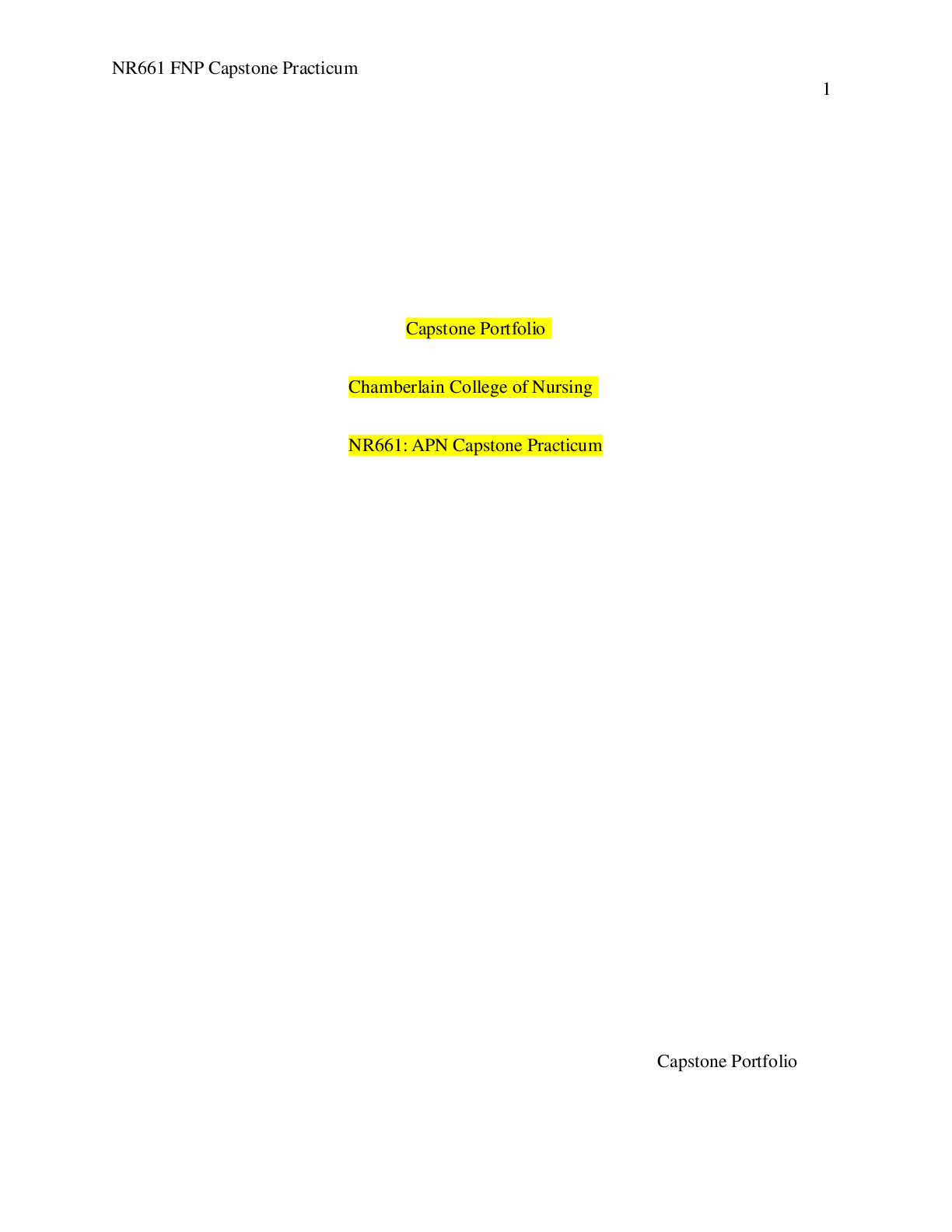
Reviews( 0 )
Document information
Connected school, study & course
About the document
Uploaded On
Sep 29, 2021
Number of pages
54
Written in
Additional information
This document has been written for:
Uploaded
Sep 29, 2021
Downloads
0
Views
38



